ZTE Z668C CDMA2000 Digital Mobile Handset User Manual
ZTE Corporation CDMA2000 Digital Mobile Handset
ZTE >
User manual
Edition Time: March 2014
Manual No.: Z8090161500MT
Z668C
User’s Manual

Table of Contents
2
About This Manual
Thank you for choosing this ZTE mobile device. In order to keep your device in its best
condition, please read this manual and keep it for future reference.
Copyright © 2014 ZTE CORPORATION
All rights reserved.
No part of this publication may be quoted, reproduced, translated or used in any form or by
any means, electronic or mechanical, including photocopying and microfilm, without the
prior written permission of ZTE Corporation.
Notice
ZTE Corporation reserves the right to make modifications on print errors or update
specifications in this manual with-out prior notice. This manual has been designed with the
utmost care to ensure the accuracy of its content. However, all statements, information
and recommendations contained therein do not constitute a warranty of any kind, either
expressed or implied. Please refer to chapter For Your Safety to be sure to use your
phone properly and safely.
We offer self-service for our smart terminal device users. Please visit the ZTE official
website (at www.ztedevice.com) for more information on self-service and supported
product models. Information on the website takes precedence.
Disclaimer
ZTE Corporation expressly disclaims any liability for faults and damages caused by
unauthorized modifications of the software.
Images and screenshots used in this manual may differ from the actual product. Content in
this manual may differ from the actual product or software.
Trademarks
ZTE and the ZTE logos are trademarks of ZTE Corporation.
Google and Android are trademarks of Google, Inc.
The Bluetooth® trademark and logos are owned by the Bluetooth SIG, Inc. and any use of
such trademarks by ZTE Corporation is under license.
microSDHC Logo is a trademark of SD-3C, LCC.
Other trademarks and trade names are the property of their respective owners.

Table of Contents
Qualcomm Snapdragon™ processors are products of Qualcomm Technologies, Inc.®
Qualcomm and Snapdragon are trademarks of Qualcomm Incorporated, registered in the
United States and other countries. Used with permission.

Table of Contents
4
Installing the Battery and a microSDHC Card .................................................... 1
Charging the Battery ........................................................................................... 2
To lock the screen and keys: ............................................................................ 3
To unlock the screen and keys: ........................................................................ 3
Using the Touch Screen ...................................................................................... 3
Getting to Know Your Phone .............................................................................. 5
Key Functions .................................................................................................. 6
Home Screen ................................................................................................... 7
Arrange & work with apps ................................................................................ 7
Changing the System Language......................................................................... 8
Protecting Your Phone With Screen Locks ........................................................ 9
Before turning on encryption, prepare as follows: ........................................... 10
When you’re ready to turn on encryption: ....................................................... 10
Monitoring the Phone Status ............................................................................ 12
Managing Notifications ..................................................................................... 13
Opening/Closing the Notification Panel .......................................................... 14
Responding to or Removing a Notification ................................................... 14
Managing Shortcuts and Widgets .................................................................... 14
Adding Shortcuts and Widgets ....................................................................... 14
Moving Shortcuts or Widgets ......................................................................... 14
Removing Shortcuts or Widgets ..................................................................... 14

Table of Contents
Adjusting Widget Size .................................................................................... 14
Organizing With Folders .................................................................................... 15
Creating a Folder ........................................................................................... 15
Renaming a Folder ......................................................................................... 15
Adding Shortcuts to a Folder .......................................................................... 15
Removing Shortcuts From a Folder ................................................................ 15
Rearranging the Favorites Tray ........................................................................ 15
Removing Items From the Favorites Tray ....................................................... 15
Adding Items to the Favorites Tray ................................................................. 15
Entering Text ...................................................................................................... 16
Changing Input Method .................................................................................. 16
Android Keyboard .......................................................................................... 16
Google Voice Typing ...................................................................................... 17
Touch Input Settings ...................................................................................... 17
Opening and Switching Apps ............................................................................ 17
Opening an App ............................................................................................. 17
Switching Between Recently Opened Apps .................................................... 18
Connecting to Mobile Networks ........................................................................ 19
Enabling or Disabling Data Access ................................................................. 19
Enable Always-on Data Access ...................................................................... 19
Getting Data Services When Roaming ............................................................ 19
Connecting to Wi-Fi ........................................................................................... 19
Turning Wi-Fi On and Connecting to a Wi-Fi Network ..................................... 19
Getting Notified of Open Networks .................................................................. 19

Table of Contents
6
Adding a Wi-Fi Network ................................................................................. 20
Forgetting a Wi-Fi Network ............................................................................. 20
Adjusting Advanced Wi-Fi Settings ................................................................. 20
Connecting to Bluetooth Devices ..................................................................... 20
Turning Bluetooth On/Off ............................................................................... 20
Changing the Device Name ........................................................................... 21
Pairing With Another Bluetooth Device ............................................................ 21
Sending Data via Bluetooth ............................................................................ 21
Connecting Your Phone to a Computer via USB ............................................ 22
Connecting with Windows Media® Player ..................................................... 22
Disconnecting Your Phone From the Computer ........................................... 22
Removing the microSDHC Card From Your Phone ........................................ 22
Erasing the microSDHC Card......................................................................... 23
Connecting to Virtual Private Networks ........................................................... 23
Adding a VPN .................................................................................................... 23
Connecting to a VPN ..................................................................................... 23
Modifying a VPN ............................................................................................ 24
Placing and Ending Calls .................................................................................. 25
Placing a Call by Dialing ................................................................................ 25
Ending a Call ................................................................................................. 25
Answering a Call ............................................................................................ 25
Rejecting a Call.............................................................................................. 25
Working With the Call Log .............................................................................. 25
Placing a Call From the Call Log .................................................................... 25
Adding a Call Log Number as a Contact ......................................................... 26

Table of Contents
Taking Other Actions on a Call Log Entry ..................................................... 26
Deleting the Call Log ...................................................................................... 26
Calling a Contact ............................................................................................ 26
Calling a Favorite Contact .............................................................................. 26
Switching Between Current Calls .................................................................... 27
Setting Up a Conference Call ......................................................................... 28
Adjusting Your Call Settings ............................................................................. 28
Editing Quick Response to Rejected Callers ................................................... 28
Setting Up Voicemail ...................................................................................... 28
Setting Up TTY Mode ..................................................................................... 28
Setting DTMF Tones ...................................................................................... 28
Setting Speed Dials ........................................................................................ 28
Forwarding Incoming Calls ............................................................................. 29
Other Options ................................................................................................. 29
Internet Call Settings ......................................................................................... 29
Adding an Internet Calling Account ................................................................. 29
Configuring Your Phone to Receive Internet Calls .......................................... 29
Checking Contact Details .................................................................................. 31
Importing Contacts From the Phone Storage .................................................. 31
Importing Contacts From the microSDHC Card .............................................. 32
Exporting Contacts to the Phone Storage ....................................................... 32
Exporting Contacts to the microSDHC Card ................................................... 32
Sharing Contacts ............................................................................................ 32
Working With Favorite Contacts ....................................................................... 32
Adding a Contact to Favorites......................................................................... 32

Table of Contents
8
Removing a Contact From Favorites .............................................................. 32
Viewing Your Contact Groups ........................................................................ 33
Setting Up a New Group ................................................................................ 33
Deleting a Group ............................................................................................ 33
Editing a Group .............................................................................................. 33
Editing Contact Details ................................................................................... 33
Setting a Ringtone for a Contact .................................................................... 33
Deleting a Contact ......................................................................................... 34
Deleting Several Contacts .............................................................................. 34
Joining Contacts ............................................................................................ 34
Separating Contact Information ...................................................................... 34
Adding or Removing Accounts ......................................................................... 36
Adding an Account ......................................................................................... 36
Removing an Account .................................................................................... 36
Configuring Account Sync ................................................................................ 36
Configuring Auto Sync Settings ...................................................................... 36
Syncing Manually ........................................................................................... 36
Changing an Account’s Sync Settings ............................................................ 36
Setting Up the First Email Account .................................................................. 38
Replying to or Forwarding an Email ................................................................ 38
Marking an Email as Unread .......................................................................... 38
Deleting an Email ........................................................................................... 38
Writing and Sending an Email .......................................................................... 39
Adding a Signature to Your Emails .................................................................. 39
Adding and Editing Email Accounts................................................................. 39

Table of Contents
Adding an Email Account ............................................................................... 39
Editing an Email Account ................................................................................ 39
Removing an Email Account ........................................................................... 40
Changing General Email Settings ..................................................................... 40
Opening Your Gmail Inbox ................................................................................ 41
Switching Accounts ........................................................................................ 41
Writing and Sending a Message........................................................................ 41
Adding a Signature to Your Gmail Messages ................................................... 41
Replying to or Forwarding a Message .............................................................. 42
Working With Received Attachments ............................................................... 42
Searching for Messages .................................................................................... 42
Working With Labels ......................................................................................... 42
Adding or Changing a Label ........................................................................... 43
Adding Stars to Messages .............................................................................. 43
Viewing Messages by Label ........................................................................... 43
Changing Gmail Settings................................................................................... 43
Opening the Messaging Screen ........................................................................ 44
Sending a Text Message ................................................................................... 44
Sending a Multimedia Message ........................................................................ 44
Replying to a Message ...................................................................................... 44

Table of Contents
10
Forwarding a Message ...................................................................................... 45
Viewing Details About a Message .................................................................... 45
Deleting Messages or Threads ......................................................................... 45
Deleting Messages in a Thread ...................................................................... 45
Delete Message Threads ............................................................................... 45
Changing Message Settings ............................................................................. 45
Viewing Your Calendars and Events ................................................................ 46
Selecting Visible Calendars ............................................................................ 46
Changing Calendar Views .............................................................................. 46
Viewing Event Details .................................................................................... 46
Creating an Event .............................................................................................. 47
Editing or Deleting an Event ............................................................................. 47
Changing Calendar Settings ............................................................................. 47
Signing In to See Your Friends ............................................................................ 48
Adding a Friend ................................................................................................. 48
Changing Your Online Status .............................................................................. 48
Chatting With Friends ....................................................................................... 48
Switching Between Active Chats .................................................................... 48
Using Group Chat .......................................................................................... 49
Ending the Chat ............................................................................................. 49
Changing Google Talk Settings ........................................................................ 49

Table of Contents
Organizing Your Contacts ................................................................................. 50
Getting Updates ................................................................................................. 50
Chatting With Contacts ..................................................................................... 50
Checking Photos ............................................................................................... 50
Checking and Managing Your Profile ............................................................. 50
Opening the Browser ......................................................................................... 52
Opening a Web Page or Searching the Web................................................... 52
Setting the Homepage .................................................................................... 52
Get Information About the Current Page ...................................................... 52
Working With an Opened Page ......................................................................... 52
Using Multiple Browser Tabs ............................................................................ 53
Opening a New Browser Tab .......................................................................... 53
Switching Between Tabs ................................................................................ 53
Downloading Files ............................................................................................. 53
Using Bookmarks .............................................................................................. 54
Bookmarking a Web Page .............................................................................. 54
Editing a Bookmark ........................................................................................ 54
Deleting a Bookmark ...................................................................................... 54
Viewing Your Browsing History ........................................................................ 54
Changing Browser Settings .............................................................................. 54
Activating Location Services ............................................................................ 56

Table of Contents
12
Getting Your Location ....................................................................................... 56
Searching for a Location ................................................................................... 56
Getting Directions to Your Destination ............................................................ 56
Searching for Local Places ............................................................................... 57
Sharing Location ............................................................................................... 57
Searching With Text .......................................................................................... 59
Searching by Speaking ..................................................................................... 59
Changing Search and Voice Search Settings .................................................. 59
Capturing a Photo ............................................................................................. 60
Customize Camera Settings ............................................................................. 60
Recording a Video ............................................................................................. 61
Customizing Camcorder ................................................................................... 61
Opening the Gallery .......................................................................................... 63
Working With Albums ....................................................................................... 63
Viewing album contents ................................................................................. 63
Sharing Albums ............................................................................................. 63
Viewing Details of an Album ........................................................................... 63
Deleting Albums ............................................................................................. 63
Working With Pictures ...................................................................................... 63
Retouching Your Pictures .............................................................................. 64

Table of Contents
Sharing Your Pictures .................................................................................... 64
Working With Videos ......................................................................................... 64
Playing Videos ............................................................................................... 64
Sharing Videos ............................................................................................... 64
Copying Music Files to Your Phone ............................................................... 65
Copying From a Computer ............................................................................. 65
Downloading From the Internet ....................................................................... 65
Receiving via Bluetooth .................................................................................. 65
Viewing Your Music Library .............................................................................. 65
Setting a Song as the Default Ringtone .......................................................... 65
Deleting a Song.............................................................................................. 66
Playing Music ..................................................................................................... 66
Managing Playlists............................................................................................. 66
Creating a Playlist .......................................................................................... 66
Adding a Song to a Playlist ............................................................................. 66
Removing a Song From a Playlist ................................................................... 66
Deleting or Renaming a Playlist ...................................................................... 67
Playing Your Music ............................................................................................ 68
Managing Playlists............................................................................................. 70
Create a Playlist or Add a Song to a Playlist ................................................... 70
Rearranging Songs in a Playlist ...................................................................... 70
Removing Songs From a Playlist .................................................................... 70
Renaming or Deleting a Playlist ...................................................................... 70

Table of Contents
14
Opening the Video Library ................................................................................ 71
Playing and Controlling Videos ........................................................................ 71
Managing Video Files ........................................................................................ 71
Sharing Videos .............................................................................................. 71
Renaming a Video ......................................................................................... 71
Viewing Details of a Video.............................................................................. 71
Recording a Voice Memo ............................................................................... 72
Playing a Voice Memo ....................................................................................... 72
Playing a Memo You Just Recorded .............................................................. 72
Playing Any Saved Memo .............................................................................. 72
Alarm .................................................................................................................. 73
Setting a New Alarm ...................................................................................... 73
Using the Bed Clock ...................................................................................... 73
Calculator .......................................................................................................... 73
Downloads ......................................................................................................... 73
File Manager ...................................................................................................... 73
Full Share ...................................................................................................... 74
Sharing Media Files on Your Phone ............................................................... 74
Note Pad ............................................................................................................ 75
Play Books .................................................................................................... 75
Play Movies & TV ............................................................................................... 75
Task Manager .................................................................................................... 75

Table of Contents
Timer .................................................................................................................. 75
World Time ......................................................................................................... 75
YouTube ............................................................................................................. 76
Browsing and Searching for Apps .................................................................... 77
Downloading and Installing Apps ..................................................................... 77
Managing Your Downloads ............................................................................... 77
Viewing Your Downloaded Apps ....................................................................... 77
Uninstalling an App ........................................................................................ 77
General Settings ................................................................................................ 78
Airplane Mode ................................................................................................ 78
Wi-Fi .............................................................................................................. 78
Bluetooth ........................................................................................................ 78
Mobile Networks ............................................................................................. 78
Sound ............................................................................................................ 78
Display ........................................................................................................... 78
Date and Time ............................................................................................... 78
Language and Input ....................................................................................... 78
Wireless and Networks ...................................................................................... 79
Data Usage .................................................................................................... 79
VPN ............................................................................................................... 79
Device ................................................................................................................. 79
Storage .......................................................................................................... 79

Table of Contents
16
Battery ........................................................................................................... 80
Apps .............................................................................................................. 80
Connect to PC ............................................................................................... 80
Personal ............................................................................................................. 80
Location Services .......................................................................................... 80
Security ......................................................................................................... 80
Backup and Reset ......................................................................................... 81
Accounts ............................................................................................................ 81
System ............................................................................................................... 81
Accessibility ................................................................................................... 81
Software Updates .......................................................................................... 81
About Phone .................................................................................................. 81
Radio Frequency (RF) Energy ............................................................................ 86
FCC Compliance ................................................................................................ 86
Using Your Phone with a Hearing Aid Device .................................................. 87
HAC for Newer Technologies ......................................................................... 88
Road Safety ....................................................................................................... 88
Driving ........................................................................................................... 88
Operating Machinery ...................................................................................... 89
Product Handling .............................................................................................. 89
General Statement on Handling and Use ..................................................... 89
Small Children ............................................................................................... 89
Demagnetization ............................................................................................ 90

Table of Contents
Electrostatic Discharge (ESD) ........................................................................ 90
Normal Use Position ....................................................................................... 90
Air Bags ......................................................................................................... 90
Seizures/Blackouts ......................................................................................... 90
Repetitive Stress Injuries ................................................................................ 90
Emergency Calls ............................................................................................ 90
Loud Noise ..................................................................................................... 90
Phone Heating ............................................................................................... 91
Electrical Safety ................................................................................................. 91
Accessories.................................................................................................... 91
Connection to a Car ....................................................................................... 91
Faulty and Damaged Products ....................................................................... 91
Interference ........................................................................................................ 91
General Statement on Interference ................................................................. 91
Pacemakers ................................................................................................... 91
Hearing Aids .................................................................................................. 91
Medical Devices ............................................................................................. 92
Hospitals ........................................................................................................ 92
Aircraft ........................................................................................................... 92
Interference in Cars ........................................................................................ 92
Gas Stations and Explosive Atmospheres ....................................................... 93
Blasting Caps and Areas ................................................................................ 93

Getting Started
1
Installing the Battery and a
microSDHC Card
Switch off your phone before installing or
replacing the battery. You have the option to
install a microSDHC card of up to 32GB to
expand your phone’s storage capacity. The
microSDHC card can be installed and
removed while the phone is turned on.
Unmount the microSDHC card before
removing it.
1. Place your finger in the slot at the bottom of
the back cover to lift and remove the cover.
2. Insert the battery by aligning the metal
contacts on the battery with the gold
contacts in the battery compartment. Gently
push down on the battery until it clicks into
place.
WARNING! Do not handle a damaged or
leaking Li-Ion battery as you can be burned.
3. Open memory card cover at the left side of
the phone an insert the microSDHC card.
NOTE: Your phone may come with a
pre-installed microSDHC card. Some
applications may not function normally after
you remove the card, pre-installed or
otherwise.
4. Push tightly until the card is installed in the
right position and close the card cover.
Getting Started

Getting Started
2
Charging the Battery
WARNING! Use only ZTE-approved
chargers and cables. The use of unapproved
accessories could damage your phone or
cause the battery to explode.
1. Connect the adapter to the charging port.
Ensure that the adapter is inserted with the
correct orientation. Do not force the
connector into the charging port.
2. Connect the charger to a standard AC wall
outlet. If the phone is on, you’ll see a
charging icon, such as or , appear in
the Status Bar.
3. Disconnect the charger when the battery is
fully charged.
Switching Your Phone On/Off
• Press and hold the Power/Lock Key to
turn on
your phone.
• To turn it off, press and hold the
Power/Lock Key to open the options
menu. Tap Power off and then tap OK.
Setting Up Your Phone for
the First Time
When you first power on your phone after you
purchase it or reset it to factory settings (see
Settings – Personal – Backup and Reset), you
may need to set it up before using it.
1. Tap the language field, select the language
you want, and tap Start.
2. Set the date, time, and time zone, or use
date and time data provided by the network.
Then tap Next.
3. If you have a Google™ account, tap Yes to
sign in. Tap No if you do not have an
account. Tap Get an account to create a
Google account or tap Not now to set up an
account later.
4. Configure the Google location options and
tap Next.
5. Enter your name, which the phone uses to
personalize some apps, and then tap Next.
6. You will be prompted to accept the Google

Getting Started
3
terms of service. Tap Next to continue.
7. Tap Finish to complete the setup.
NOTE: If the phone is not activated, it would
prompt you to connect to a Wi-Fi network
before asking you to sign in to a Google
account.
Locking/Unlocking the Screen and
Keys
Your phone allows you to quickly lock the
screen and keys (put the phone into Sleep
mode) when not in use, and also to turn the
screen back on and unlock it when you need it.
To lock the screen and keys:
To quickly turn the screen off and lock the
keys, press the Power/Lock Key.
NOTE: To save battery power, the phone
automatically turns off the screen after a
certain period of time when you leave it idle.
You will still be able to receive messages and
calls while the phone screen is off.
To unlock the screen and keys:
1. Press the Power/Lock Key to turn the
screen on.
2. Long press screen to unlock.
NOTE: If you have set an unlock pattern, PIN,
or password for your phone (see Personalizing
– Protecting Your Phone With Screen Locks),
you’ll need to draw the pattern or enter the
PIN/password to unlock your screen.
Using the Touch Screen
Your phone’s touch screen lets you control
actions through a variety of touch gestures.
• Tap – When you want to type using the
on-screen keyboard, select items
on-screen (such as application and
settings icons), or press on-screen buttons,
simply tap them with your finger.
• Tap and Hold – To open the available
options for an item (for example, a
message or link in a web page), tap and
hold the item.
• Swipe or Slide – To swipe or slide means
to quickly drag your finger vertically or
horizontally across the screen.
• Drag – To drag, press and hold your finger
with some pressure before you start to

Getting Started
4
move your finger. While dragging, do not
release your finger until you have reached
the target position.
• Pinch – In some apps (such as Maps,
Browser, and Gallery), you can zoom in
and out by placing two fingers on the
screen at once and pinching them together
(to zoom out) or spreading them apart (to
zoom in).
• Rotate the screen – For most screens,
you can automatically change the screen
orientation from portrait to landscape by
turning the phone sideways.
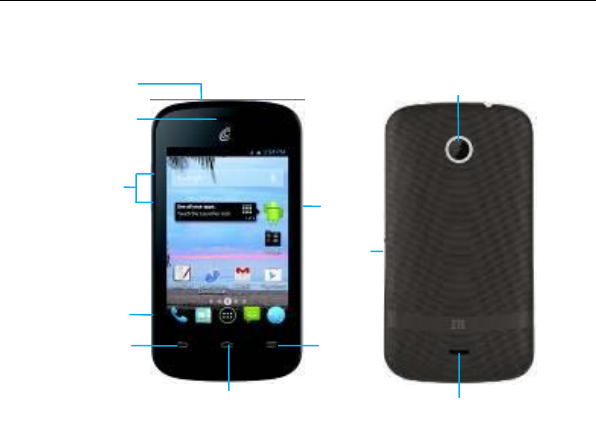
Getting Started
5
3.5mm
Headset Jack
End/Power key
Micro USB
Charging Port
Earpiece
Volume
Up/Down Keys
Back Key
Microphone
micro SD
card slot
Battery
Cover
Camera
Speaker
Menu Key
Getting to Know Your Phone

Getting Started
6
Key Functions
Key
Description
Power/Lock
Key
Press and hold to turn on or off Airplane mode, enable silent
mode/vibration mode/sound, or to power off.
Press to switch your phone to Sleep mode.
Press to wake up your phone.
Home Key
Press to return to the Home Screen from any application or screen.
Press and hold to see recently used applications.
Menu Key
Press for current screen options.
Back Key
Press to go to the previous screen.
Volume Keys
Press or hold to turn the volume up or down.
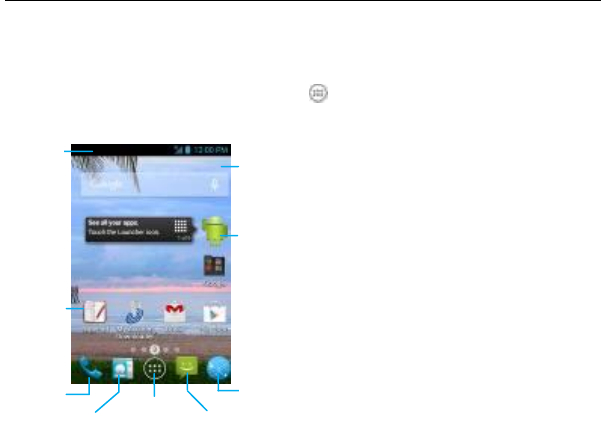
Getting Started
7
Earpiece
Shortcut
s
Tap to open
the main
menu
Wallpaper
t
Widget
Tap to open
contacts
Tap to open
messaging
Tap to open
the web
browser
Tap to
open the
dialer
Home Screen
You can customize your Home Screen. Set
your own wallpaper, add the widgets or
application shortcuts you need, or remove
them as you like.
Arrange & work with apps
Too see all your apps, touch the All Apps Icon
on any Home screen. After opening the All
Apps, press an icon to enter the corresponding
application. Touch the Back key to return to
the previous screen. Touch the Home key to
return to the home screen.
From All Apps, you can:
• Explore your widgets: Touch the widgets
tab at the top of any All Apps screen.
• Get more apps.: Touch the Play Store
icon at the top of any All Apps screen.
On the home screen, touch & hold the Home
key, opens a list of thumbnail images of apps
you’ve worked with recently. To open an app,
touch it. To remove a thumbnail from the list,
swipe it left or right.
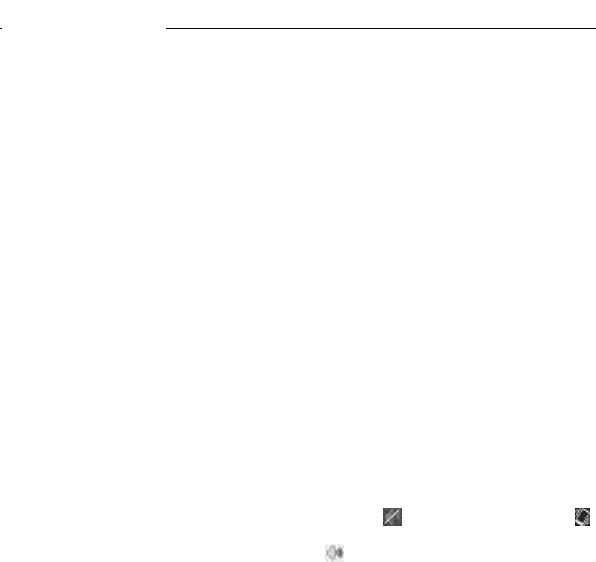
Personalizing
8
Changing the System Language
1. Press the Home Key > Menu Key >
System settings > Language & input >
Language.
2. Select the language you need.
Changing the Ringtone
You can customize the default ringtone for
incoming calls by taking the following steps.
1. Press the Home Key > Menu
Key >Settings > Sound.
2. Tap Phone ringtone.
3. Scroll through the ringtone list and select the
ringtone you want to use.
4. Tap OK.
TIP: See People – Editing Contacts – Setting
a Ringtone for a Contact for how to assign a
special ringtone to an individual contact.
Changing the Notification Sound
You can customize the default notification
sound by taking the following steps.
1. Press the Home Key > Menu Key >
Settings >Sound.
2. Tap Notification ringtone.
3. Scroll through the list and select the ringtone
you want to use.
4. Tap OK.
Turning On/Off Touch Sounds
1. Press the Home Key > Menu Key >
System settings > Sound.
2. Check or uncheck Touch sounds.
Adjusting Volumes
1. Press the Home Key > Menu Key >
System settings > Sound > Volumes.
2. Drag the sliders to adjust the volume for
each type of audio.
3. Tap OK to save.
TIP: You can adjust the media volume when a
media application is in use by pressing the
Volume Up/Down Keys. If no media
application is active, press the Volume
Up/Down Keys to adjust ringtone volume (or
the earpiece volume during a call).
Switching to Silent Mode
You can set the phone to silent mode by using
one of the following methods:
• Press and hold the Power/Lock Key and
then tap to enable silent mode, tap
to enable silent
mode with vibration, or tap
to disable silent mode.
• Keep pressing the Volume Down Key
Personalizing

Personalizing
9
when no media application is active. When
the icon appears in the Status Bar, the
phone is set to silent mode with vibration.
When the icon appears in the Status
Bar, the phone is in silent mode.
• Press the Home Key > Menu Key >
System settings > Sound > Silent mode,
and tap Vibrate or Mute.
Applying New Wallpapers
You can set the wallpaper for the Home
Screen or Lock Screen.
1. Press the Home Key > Menu Key >
Wallpaper.
2. Tap Home or Lock screen.
3. Select a wallpaper source from Gallery,
Live Wallpapers, or Wallpapers and
choose the image or animation you want to
use as the wallpaper. Some cropping may
be needed for Gallery images.
4. Tap Set wallpaper.
NOTE: Live Wallpapers are not available for
the Lock Screen.
Changing the Screen Brightness
1. Press the Home Key > Menu Key >
System settings > Display > Brightness.
2. Check the Automatic brightness box to
make the phone adjust the screen
brightness automatically, or clear the check
box to adjust the brightness manually.
3. Tap OK.
Protecting Your Phone With
Screen Locks
You can protect your phone by creating a
screen lock. When enabled, you need to draw
a pattern or enter a numeric PIN or password
to unlock the phone’s screen and keys.
1. Press the Home Key > Menu Key >
System settings > Security.
2. Tap Screen lock.
3. Tap Pattern, PIN, or Password.
• If you tap Pattern, you’ll need to create a
pattern you must draw to unlock the screen.
The first time you do this, a short tutorial
about creating an unlock pattern appears.
Then you’ll be prompted to draw and
redraw your own pattern.
• If you tap PIN or Password, you’ll be
prompted to set a numeric PIN or a
password that you must enter to unlock
your screen.
The next time you turn on your phone or wake
up the screen, you must draw your unlock
pattern or enter your PIN or password to
unlock it.

Personalizing
10
IMPORTANT: If you forget the pattern you
set, try five times and tap Forget pattern? to
sign in to the Google account you have added
on the phone and reset the screen lock. You
will need an active Internet connection. You
can also upgrade the phone software.
Protecting Your Phone With
Encryption
You can encrypt all the data on your phone:
Google accounts, application data, music and
other media, downloaded information, and so
on. If you do, you must enter a numeric PIN or
password each time you power on your phone.
WARNING! Encryption is irreversible. The
only way to revert to an unencrypted phone is
to perform a factory data reset, which erases
all your data.
Encryption provides additional protection in
case your phone is stolen, and may be
required or recommended in some
organizations. Consult your system
administrator before turning it on. In many
cases the PIN or password you set for
encryption is controlled by the system
administrator.
Before turning on encryption, prepare
as follows:
1. Set a lock screen PIN or password.
2. Charge the battery.
3. Keep the phone connected to the charger.
4. Schedule an hour or more for the encryption
process. You must not interrupt it or you will
lose some or all of your data.
When you’re ready to turn on
encryption:
1. Press the Home Key > Menu Key >
System settings > Security > Encrypt
phone.
2. Read the information about encryption
carefully.
The Encrypt phone button is dimmed if
your battery is not charged or your phone is
not plugged in. If you change your mind
about encrypting your phone, press the
Back Key.
WARNING! If you interrupt the encryption
process, you will lose data.
3. Tap Encrypt phone.
4. Enter your lock screen PIN or password and
tap Next.
5. Tap Encrypt phone again.
The encryption process starts and displays its

Personalizing
11
progress. Encryption can take an hour or more,
during which time your phone may restart
several times.
When encryption is complete, you’ll be
prompted to enter your PIN or password.
Subsequently, you must enter your PIN or
password each time you power on your phone
to decrypt it.
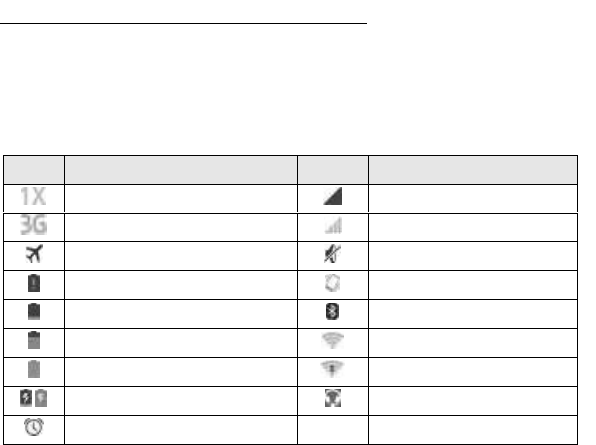
Knowing the Basics
12
Monitoring the Phone Status
The Status Bar at the top of the Home Screen provides phone and service status icons on the
right side.
Below are some of the icons you may see.
Indicators and Icons
Indicator
What it means
Indicator
What it means
1X network connected
No signal
3G network connected
Signal strength
Flight mode
Ringer off
Battery empty
Vibrate mode
Battery low
Bluetooth on
Battery partly drained
Connected to a Wi-Fi network
Battery full
Wi-Fi in use
/
Battery charging
Wired headset connected
Alarm set
Knowing the Basics
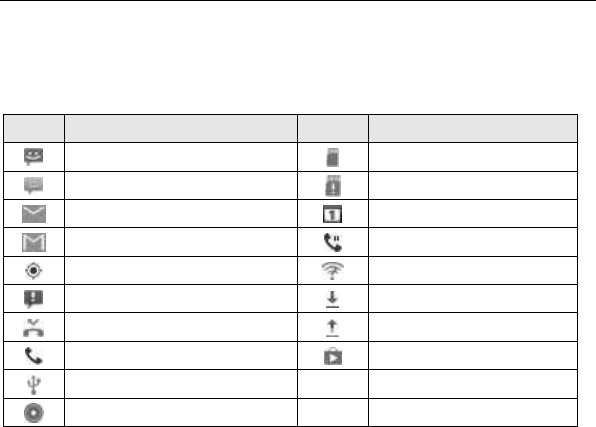
Knowing the Basics
13
Managing Notifications
The Status Bar at the top of the Home Screen provides notification icons on the left.
Below are some of the icons you may see.
Indicators and Icons
Indicator
What it means
Indicator
What it means
New SMS
microSDHC card unmounted
New MMS
microSDHC card removed
New email
Upcoming event
New Gmail message
Call on hold
GPS on
New Wi-Fi network detected
Problem with SMS/MMS delivery
Downloading data
Missed call
Sending data
Call in progress
Updates available
USB connected
Song is playing

Knowing the Basics
14
Opening/Closing the Notification Panel
Notifications report the arrival of new
messages, calendar events, and alarms, as
well as ongoing events. You can open the
Notification Panel to view the details of
notifications.
• To open the Notification Panel, swipe your
finger down from the top of the screen.
• To close the Notification Panel, swipe your
finger up from the bottom of the screen or
tap the Back Key.
Responding to or Removing
a Notification
In the Notification Panel, you can respond to a
notification or remove the notifications.
• To respond to a notification, tap it.
• To remove a notification, swipe it left or
right.
• To remove all notifications, tap in the
top
right corner.
• Most apps that send notifications, such as
Gmail
and Google Talk, have notification settings
that you can adjust.
TIP: In the Notification Panel, tap at the
top of notifications list to get to the Settings
menu quickly.
Managing Shortcuts and
Widgets
Adding Shortcuts and Widgets
1. Press the Home Key > > Widgets.
2. Tap Widgets or Shortcuts to view the
available widgets and shortcuts.
3. Tap and hold a widget or shortcut and drag
it to the Home Screen.
Moving Shortcuts or Widgets
1. Tap and hold a widget or shortcut on the
Home Screen.
2. Drag it to the place you need.
Removing Shortcuts or Widgets
1. Tap and hold a widget or shortcut on the
Home Screen.
2. Drag it to to remove it.
Adjusting Widget Size
1. Tap and hold a widget on the Home Screen
and then release it.
2. An outline appears around the widget. Drag
the outline to resize the widget.

Knowing the Basics
15
NOTE: Not all widgets can be resized.
Organizing With Folders
You can create folders on the Home Screen
and add several shortcuts in a folder.
Creating a Folder
1. Tap and hold the shortcut on the Home
Screen you want to add into a folder until
appears.
2. Drag the shortcut to and release it. A
new folder will be created and the shortcut is
added to the folder.
Renaming a Folder
1. Tap a folder to open it.
2. Tap the folder name field and enter a new
name.
Adding Shortcuts to a Folder
1. Tap and hold a shortcut and then drag it
onto a folder icon.
2. Release the shortcut and it will be added
into the folder.
Removing Shortcuts From a Folder
1. Tap a folder to open it.
2. Tap and hold the shortcut you want to
remove and then drag it to the Home Screen.
3. Release the shortcut and it will be removed
from
the folder.
Rearranging the Favorites Tray
The Home Screen includes a customizable
favorites tray at the bottom of all Home
Screens. You can drag apps, shortcuts,
folders, and other priority items in or out of the
favorites tray for instant access from any
Home Screen.
Removing Items From the Favorites
Tray
Tap and hold an item in the favorites tray and
drag it out of the tray.
Adding Items to the Favorites Tray
Tap and hold an item on the Home Screen and
drag it into the favorites tray.
If the favorites tray is full, you need to remove
an item in the tray.
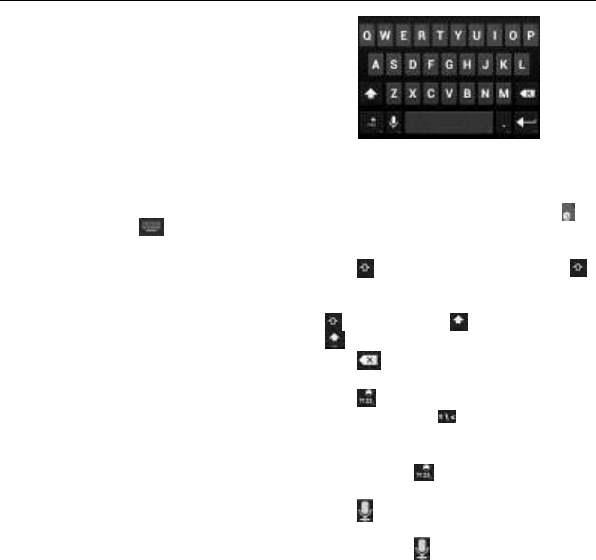
Knowing the Basics
16
Entering Text
You can enter text using the on-screen
keyboard. Some apps open it automatically. In
others, you open it by tapping where you want
to type. You can press the Back Key to hide
the on-screen keyboard.
Changing Input Method
1. When you use the on-screen keyboard to
enter text, the icon appears in the
Status bar.
2. Open the Notification Panel and tap Choose
input method.
3. Select an input method.
Android Keyboard
The Android Keyboard provides a layout
similar to a desktop computer keyboard. Turn
the phone sideways and the keyboard will
change from portrait to andscape. The
landscape keyboard is not supported in all
applications.
• Tap the alphabetic keys to enter letters.
Tap and hold some specific keys to enter
associated accented letters or numbers.
For example, to enter è, tap and hold
and the available accented letters and
number 3 appear. Then slide to choose è.
• Tap to use uppercase. Double-tap
to lock uppercase. This key also changes
to indicate the current case you are using:
for lowercase, for uppercase, and
when locked in uppercase.
• Tap to delete the text before the
cursor.
• Tap to select numbers and symbols.
You can then tap to find more. Also,
often-used symbols are displayed above
the keyboard.
• Tap and hold and then swipe to
choose the emoticons.
• Tap to use Google’s networked voice
input.
• Tap and hold to change the input
language or access the Android keyboard
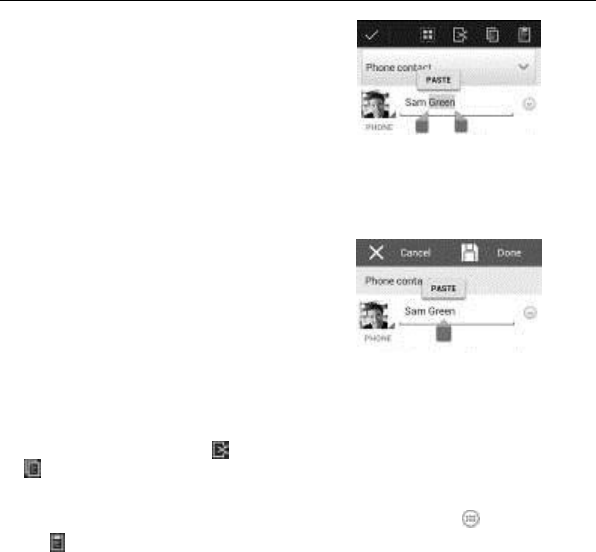
Knowing the Basics
17
settings.
Google Voice Typing
Use Google’s networked voice input.
Touch Input Settings
Choose the touch input settings by pressing
the Home Key > Menu Key > System
settings > Language & input.
In the KEYBOARD & INPUT METHODS
section, you can set the default input method
and choose the settings for input methods.
Editing Text
• Move the insertion point: Tap where you
want to type. The cursor blinks in the new
position, and a tab appears below it. Drag
the tab to move the cursor.
• Select text: Tap and hold or double-tap
within the text. The nearest word highlights,
with a tab at each end of the selection.
Drag the tabs to change the selection.
• Cut or copy: Select the text you want to
manipulate. Then tap the Cut or Copy
button to cut or copy the text to the
clipboard.
• Replace text with the clipboard text:
Select the text you want to replace. Then
tap or PASTE.
• Insert text from the clipboard: Move the
cursor to the insertion point and then tap
and hold the tab below the cursor. Release
your finger and tap PASTE.
Opening and Switching Apps
Opening an App
1. Press the Home Key > .
2. Slide left or right on the screen and tap an
app to open it.

Knowing the Basics
18
Switching Between Recently Opened
Apps
1. Press and hold the Home Key. A list of the
names and thumbnails of apps you’ve
recently used opens. If you’ve been using
more apps recently than can fit on the
screen, you can scroll the list up and down.
2. Tap a thumbnail to open that app. You can
swipe a thumbnail sideways to remove it
from the list.

Connecting to Networks and Devices
19
Connecting to Mobile Networks
Enabling or Disabling Data Access
1. Press the Home Key > Menu Key > System
settings > Mobile networks.
2. Check Data enabled to enable data access
over the mobile network. Clear the check box
to disable data access.
Enable Always-on Data Access
1. Press the Home Key > Menu Key > System
settings > Mobile networks.
2. Check Always-on mobile data to allow
applications to update data automatically.
IMPORTANT: When you enable this option,
more data traffic will be generated for automatic
updates of applications data. Your phone will
also consume more power.
Getting Data Services When Roaming
1. Press the Home Key > Menu Key > System
settings > Mobile networks.
2. Check Data roaming.
IMPORTANT: Depending on your service
provider and rate plan, data roaming may incur
significant roaming charges.
Connecting to Wi-Fi
Wi-Fi is a wireless networking technology that
can provide Internet access at distances of up
to 100 meters, depending on the Wi-Fi router
and your surroundings.
Turning Wi-Fi On and Connecting to a
Wi-Fi Network
1. Press the Home Key > Menu Key > System
settings > Wi-Fi.
2. Slide the Wi-Fi switch to the ON position to
turn
on Wi-Fi.
3. Tap a network name to connect to it.
4. If the network is secured, enter the password
and tap Connect.
NOTE: Your phone automatically connects to
previously used Wi-Fi networks when they are
in range.
Getting Notified of Open Networks
1. Press the Home Key > Menu Key > System
settings > Wi-Fi.
2. Slide the Wi-Fi switch to the ON position.
3. Press the Menu Key > Advanced.
4. Check Network notification.
When Wi-Fi is on, you receive notifications in
the Status Bar when your phone detects an
open Wi-Fi network. Uncheck the option to turn
off notifications.
Connecting to Networks and Devices

Connecting to Networks and Devices
20
Adding a Wi-Fi Network
You can add a Wi-Fi network if the network
does not broadcast its name (SSID) or add a
Wi-Fi network when you are out of range.
To connect to a secured network, you first need
to get the security details from the network’s
administrator.
1. Press the Home Key > Menu Key > System
settings > Wi-Fi.
2. Slide the Wi-Fi switch to the ON position.
3. Tap Add network.
4. Enter the network SSID (name). If necessary,
enter security or other network configuration
details.
5. Tap Save.
Forgetting a Wi-Fi Network
You can make your phone forget the details of
a Wi-Fi network that you added—for example, if
you don’t want the phone to connect to it
automatically or if it is a network that you no
longer use.
1. Press the Home Key > Menu Key > System
settings > Wi-Fi.
2. Slide the Wi-Fi switch to the ON position.
3. Tap the Wi-Fi network name and then tap
Forget.
Adjusting Advanced Wi-Fi Settings
1. Press the Home Key > Menu Key > System
settings > Wi-Fi.
2. Press the Menu Key > Advanced to adjust
the following settings.
• Network notification: Get notifications in
the Status Bar when Wi-Fi is on and an
open network is available.
• Keep Wi-Fi on during sleep: Choose
whether or not to keep Wi-Fi on in Sleep
mode.
• Avoid no Internet connections: Only use
a Wi-Fi network when the Internet
connection is good.
• MAC address: Check the MAC address.
• IP address: Check the phone’s IP address.
Connecting to Bluetooth Devices
Bluetooth is a short-range wireless
communication technology. Phones or other
devices with Bluetooth capabilities can
exchange information wirelessly within a
distance of about 32 feet (10 meters). The
Bluetooth devices must be paired before the
communication is performed.
Turning Bluetooth On/Off
1. Press the Home Key > Menu Key > System
settings > Bluetooth.

Connecting to Networks and Devices
21
2. Slide the Bluetooth switch to the ON or OFF
position.
When Bluetooth is on, the icon will appear
in the Status Bar.
Changing the Device Name
1. Press the Home Key > Menu Key > System
settings > Bluetooth.
2. Slide the Bluetooth switch to the ON position
if Bluetooth is off.
3. Press the Menu Key > Rename phone.
4. Edit the name and tap Rename.
Pairing With Another Bluetooth
Device
1. Press the Home Key > Menu Key > System
settings > Bluetooth.
2. Slide the Bluetooth switch to the ON position
if Bluetooth is off.
Your phone automatically scans for and
displays the IDs of all available Bluetooth
devices in range. Tap SEARCH FOR DEVICES
if you want to scan again.
3. Tap the device you want to pair with.
4. If necessary, confirm that the Bluetooth
passkeys are the same between the two
devices and tap Pair. Alternately, enter a
Bluetooth passkey and tap Pair.
Pairing is successfully completed when the
other device accepts the connection or the
same passkey is entered.
NOTE: The Bluetooth passkey may be fixed for
certain devices, such as headsets and
hands-free car kits. You can try entering 0000
or 1234 (the most common passkeys) or refer
to the documents for that device.
Sending Data via Bluetooth
1. Open the appropriate application and select
the file or item you want to share.
2. Select the option for sharing via Bluetooth.
The method may vary by application and
data type.
3. Tap a Bluetooth device the phone has paired
with or wait for it to search for new devices
and tap one of them.
Receiving Data via Bluetooth
1. Turn Bluetooth on before trying to receive
data via Bluetooth.
NOTE: If the phone has not been paired with
the sending device, you may need to tap
Bluetooth >
Z668C in Settings to keep the phone
detectable through Bluetooth.

Connecting to Networks and Devices
22
2. Flick down the Status Bar and tap .
3. Tap Accept to start receiving the data.
Received files are stored automatically in a
dedicated folder (Bluetooth, for instance). You
can access them with the File Manager app.
Received contacts (vCard files) are
automatically imported to your contact list.
Connecting to Your Computer via
USB
You can connect your phone to a computer with
a USB cable and transfer music, pictures, and
other files in both directions. Your phone stores
these files in internal storage or on a removable
microSDHC card.
Connecting Your Phone to a Computer
via USB
1. Connect your phone to the PC with a USB
cable.
2. Press the Home Key > Menu Key > System
settings > Connect to PC.
3. Choose one of the following options:
• Charger only: charge your phone via USB.
• USB mass storage: Transfer files between
PC and external SD card on Android device.
• Install driver: Select the option when the
features (Connect to PC software, Media
device) enabled for the first time, or when
they’re unavailable.
• Media device (MTP): Transfer media files
on a Windows-based PC or with Android
File Transfer on a Mac.
• Camera (PTP): Transfer photos using
camera software and transfer any files to a
computer that doesn’t support MTP.
Connecting with Windows
Media® Player
You can sync music with your phone and your
computer installed with Windows Media Player.
1. Connect the phone with your computer via
USB and choose Media device (MTP).
2. Open Windows Media Player and
synchronize
music files.
Disconnecting Your Phone From
the Computer
To disconnect the phone from the computer,
simply unplug the USB cable when you’re
finished.
Removing the microSDHC Card From
Your Phone
If you need to remove the microSDHC card
while the phone is on, you should unmount it

Connecting to Networks and Devices
23
first.
1. Press the Home Key > Menu Key > System
settings > Storage.
2. Scroll down and tap Unmount SD card >
OK.
3. The icon appears in the Status Bar and
you
can now safely remove the microSDHC card
from the phone.
Erasing the microSDHC Card
1. Press the Home Key > Menu Key > System
settings > Storage.
2. Scroll down the screen and tap Erase SD
card > Erase SD card > Erase everything.
CAUTION! The formatting procedure erases
all the data on the microSDHC card, after which
the files CANNOT be retrieved.
Connecting to Virtual Private
Networks
Virtual private networks (VPNs) allow you to
connect
to the resources inside a secured local network.
VPNs are commonly deployed by corporations,
schools, and other institutions to let people
access local network resources when not on
campus, or when connected to
a wireless network.
Depending on the type of VPN you are using,
you may be required to enter your login
credentials or install security certificates before
you can connect to your VPN. You can get this
information from your network administrator.
Adding a VPN
1. Press the Home Key > Menu Key > System
settings > More > VPN.
2. You may be prompted to set a lock screen
(see Personalizing – Protecting Your Phone
With Screen Locks). If not, tap Add VPN
profile and fill in the information provided by
your network administrator.
3. Tap Save.
The VPN is added to the list on the VPN
screen.
Connecting to a VPN
1. Press the Home Key > Menu Key > System
settings > More > VPN.
2. Tap the VPN that you want to connect to.
3. When prompted, enter any requested
credentials and then tap Connect.

Connecting to Networks and Devices
24
When you are connected, the VPN
connected icon appears in the Status Bar.
Modifying a VPN
1. Press the Home Key > Menu Key > System
settings > More > VPN.
2. Tap and hold the VPN that you want to
modify.
3. Tap Edit profile and edit the VPN settings.
4. Tap Save.

Phone Calls
25
You can place calls from the Phone app, the
People app, or other apps or widgets that
display contact information. Wherever you see
a phone number, you can usually tap it to dial.
Placing and Ending Calls
Placing a Call by Dialing
1. Press the Home Key > .
2. In the dialer tap , enter the phone
number with the on-screen keypad. Tap
to delete incorrect digits.
NOTE: As you enter digits, your phone
searches for contacts that match. If you see the
number you want to dial, tap it to place the call
immediately without entering the rest of the
number.
3. Tap below the keypad to dial.
TIP: To make an international call, tap and hold
the 0 key to enter the plus (+) symbol. Next,
enter the country code followed by the city/area
code and then the phone number.
Ending a Call
During a call, tap on the screen.
Answering or Rejecting Calls
When you receive a phone call, the Incoming
Call screen opens, displaying the Caller ID or
the information about the caller that you’ve
entered in People. You can answer or reject the
call, or reject it with a text message.
Answering a Call
When you receive a phone call, drag over
to answer the call.
NOTE: To silence the ringer before answering
the call, press the Volume Up/Down Keys.
Rejecting a Call
When you receive a phone call, drag over
to reject the call.
You can also drag over to reject the
call and send a preset text message to the
caller.
TIP: To edit the text response from within the
Phone app, tap the Menu Key > Settings >
Quick responses.
Working With the Call Log
The Call Log is a list of all the calls you’ve
placed, received, or missed. It provides a
convenient way to redial a number, return a call,
or add a number to your Contacts.
To open the call log, press the Home Key >
> Call log or tap the tab in the Phone
app.
Placing a Call From the Call Log
1. Open the Call Log.
Phone Calls

Phone Calls
26
2. Tap a number for more information about the
call, or tap beside it to call back.
NOTE: You can tap on the bottom of the
screen and select the type of call log you want
to view.
Adding a Call Log Number as a Contact
1. Open the Call Log.
2. Tap a number to view more call information.
3. Tap at the top right of the screen.
4. To add the number to an existing contact, tap
Add to existing. To add a new contact, tap
New contact.
Taking Other Actions on a Call
Log Entry
1. Open the Call Log.
2. Tap a number to view more call information.
While viewing the call details, you can:
• Tap to call a number.
• Tap > Edit number before call to edit
the number in the dialer before calling it.
• Tap to send a message.
• If the number belongs to a contact you
already have, tap to view contact
details.
Deleting the Call Log
1. Open the Call Log.
2. Press the Menu Key > Multi-Select.
3. Tap the call log items you want to delete and
then tap > Delete to delete the call logs.
NOTE: You can also tap a number in the call
log screen, and tap at the bottom to delete
the call log of the number.
Calling Your Contacts
Calling a Contact
1. Press the Home Key > and then tap the
Contacts tab .
2. Flick the screen up or down to view all your
contacts with phone numbers.
TIP: You can search for a contact by tapping
on the screen.
3. Tap a contact or number to call it.
Calling a Favorite Contact
1. Press the Home Key > and then tap the
Contacts tab .
2. Your favorite contacts and frequently called
contacts or numbers are listed at the top of
the screen. Tap a contact or number to call it.
Checking Voicemail
If you have set the phone to divert certain calls
to voicemail, callers can leave voicemail
messages when they cannot reach you. Here’s

Phone Calls
27
how to check the messages they left.
1. Press the Home Key > .
2. Tap and hold “1” in the dialer. If prompted,
enter your voicemail password.
3. Follow the voice prompts to listen to and
manage your voicemail messages.
NOTE: To set your voicemail service, press the
Menu Key > Settings in the dialer and tap the
voicemail settings you want to change. For
detailed information, please contact your
service provider.
Using Options During a Call
During a call, you will see a number of
on-screen options. Tap an option to select it.
• Tap to turn the speaker on or off.
• Tap to mute or unmute the microphone.
• Tap to hold or unhold the current call.
• Tap to make another call separately
from the first call, which is put on hold.
• Tap to switch to the dialer, for example
to enter a code.
• Press the Menu Key for more call options.
You can record a phone conversation, or
view the contact list.
• Tap to merge the separate calls into a
single conference call.
• Tap to end the current call.
WARNING! Because of higher volume levels,
do not place the phone near your ear during
speakerphone use.
Managing Multi-party Calls
When the call waiting and three-way call
features are available, you can switch between
two calls or set up a conference call.
NOTE: The call waiting and three-way call
features need network support and may result
in additional charges. Please contact your
service provider for
more information.
Switching Between Current Calls
When you’re on a call, your phone screen
informs you that another call is coming in and
displays the caller ID.
To respond to an incoming call while you’re
on a call:
Drag over to answer the call. This puts
the first caller on hold and answers the second
call.
To switch between two calls:
Press .

Phone Calls
28
Setting Up a Conference Call
With this feature, you can talk to two people at
the same time.
1. On the dialer screen, enter a number and tap
.
2. Once you have established the connection,
tap and dial the second number. This
puts the first caller on hold and dials the
second number.
3. When you’re connected to the second party,
tap .
If one of the people you called hangs up during
your call, you and the remaining caller stay
connected. If you initiated the call and are the
first to hang up, all callers are disconnected.
To end the conference call, tap .
Adjusting Your Call Settings
Editing Quick Response to Rejected
Callers
1. Press the Home Key > .
2.
Press the
Menu Key > Settings > Quick
responses
.
3. Tap the text message to edit it.
Setting Up Voicemail
1. Press the Home Key > .
2. Press the Menu Key > Settings.
3. Tap Voicemail > Service to select voicemail
service provider. Your carrier is the default.
Setting Up TTY Mode
Select a TTY mode for your phone to work with
a teletypewriter or turn TTY off.
1. Press the Home Key > .
2. Press the Menu Key > Settings > TTY
mode.
3. Tap TTY Off to turn the feature off, or tap
TTY Full, TTY HCO, or TTY VCO to select a
mode for your phone to work with the
teletypewriter. Consult your teletypewriter
manufacturer’s manual if necessary.
Setting DTMF Tones
You can set the length of Dual-tone
multi-frequency (DTMF) signal tones.
1. Press the Home Key > .
2. Press the Menu Key > Settings > DTMF
tones.
3. Tap Normal or Long.
Setting Speed Dials
You can press and hold the 2 - 9 keys from the
dialer to call the corresponding speed dial
number.
The number 1 key is reserved to speed dial
your voicemail.

Phone Calls
29
To assign a speed dial key:
1. Press the Home Key > .
2. Press the Menu Key > Settings > Speed
dial.
3. Tap a speed dial key.
4. Enter a phone number or tap to select
one from the contact list.
5. Tap OK.
Forwarding Incoming Calls
Call forwarding feature allows you to forward
your incoming calls to another phone number.
1. Press the Home Key > .
2. Press the Menu Key > Settings > Call
forwarding.
3. Tap an available option (Always forward,
Forward when busy, or Forward when
unanswered) to enable it.
Other Options
1. Press the Home Key > .
2. Press the Menu Key > Settings >
Additional settings.
Check Voice privacy to enable enhanced
privacy mode. Tap Plus Code Dialing Setting
to set the Plus Code dialing.
Internet Call Settings
Adding an Internet Calling Account
To add an Internet calling account:
1. Press the Home Key > .
2. Press the Menu Key > Settings >
Accounts.
3. Tap Add account.
4. Follow the instructions from your Internet
calling service provider to configure the
settings for your account.
5. Press the Menu Key > Save.
To configure which calls use Internet
calling:
You can configure your phone to place all calls
using Internet calling (when you’re connected
to a Wi-Fi network), just calls to Internet calling
addresses, or to ask each time you place a call.
1. Press the Home Key > .
2. Press the Menu Key > Settings > Use
Internet calling.
3. Tap the Internet calling option you want.
Configuring Your Phone to Receive
Internet Calls
By default, your phone is configured to make
Internet calls, but not to ensure that you will
receive them. But you can configure your
phone to listen for Internet calls made to an

Phone Calls
30
Internet calling account you added to
your phone.
1. Press the Home Key > .
2. Press the Menu Key > Settings >
Accounts.
3. Check Receive incoming calls. Checking
this setting will reduce your battery life between
charges.

People
31
You can add contacts on your phone and
synchronize them with the contacts in your
Google account or other accounts that support
contact syncing.
To see your contacts, press the Home Key >
. From there, you can tap the tabs to quickly
switch to the contact groups or favorite
contacts .
Checking Contact Details
1. Press the Home Key > and tap the
Contacts tab to access your contact
list.
2. Scroll through the list to view all your
contacts.
3. Tap a contact to view its details.
TIP: If you have a lot of contacts stored, you’ll
see a slider when you tap the right side of the
screen. To go directly to a letter, tap and hold
the slider and drag it to a letter.
Adding a New Contact
1. Press the Home Key > and tap the
Contacts tab .
2. Tap to add a new contact.
3. Tap the account field to choose where to
save the contact. If a sync account is
selected, the contacts will be synced
automatically with your account online.
4. Enter the contact name, phone numbers,
email addresses, and other information.
5. Tap Done to save the contact.
Setting Up Your Own Profile
You can create your own name card in your
phone.
1. Press the Home Key > and tap the
Contacts tab .
2. Tap Set up my profile or your name,
whichever is at the top of the contact list.
3. Edit your profile information and tap Done.
Importing, Exporting, and Sharing
Contacts
You can import/export contacts to/from your
phone storage or microSDHC card. This is
especially useful when you need to transfer
contacts between different devices. You can
also quickly share your contacts using
Bluetooth, Email, Messages, etc.
Importing Contacts From the Phone
Storage
1. Press the Home Key > .
2. Press the Menu Key > Import/export >
Import from phone storage.
People

People
32
3. Select the vCard file(s) in the phone storage
and
tap OK.
Importing Contacts From the
microSDHC Card
1. Press Home Key > .
2. Press the Menu Key > Import/export >
Import from SD card.
3. Select the vCard file(s) in the microSDHC
card and
tap OK.
Exporting Contacts to the Phone Storage
1. Press the Home Key > .
2. Press the Menu Key > Import/export >
Export to phone storage.
3. The phone will prompt you with the name of
the vCard file. Tap OK to create the file in the
phone storage.
Exporting Contacts to the microSDHC
Card
1. Press the Home Key > .
2. Press the Menu Key > Import/export >
Export to SD card.
3. The phone will prompt you with the name of
the vCard file. Tap OK to create the file on
the microSDHC card.
Sharing Contacts
1. Press the Home Key > and tap the
Contacts tab .
2. Press Menu Key > Multi-Select.
3. Tap the contacts you want to share and then
tap .
4. Choose to share the contacts via Bluetooth,
Email, Gmail or Messages.
Working With Favorite Contacts
In the Favorite Contacts tab, you can find your
favorite contacts and frequently used contacts.
Adding a Contact to Favorites
You can add the contacts used frequently to
Favorites so you can find them quickly.
1. Press the Home Key > and tap the
Contacts tab .
2. Tap a contact and then tap next to the
contact name.
Removing a Contact From Favorites
1. Press the Home Key > and tap the
Favorites tab .
2. Tap a favorite contact and then tap next
to the contact name.

People
33
Working With Groups
Viewing Your Contact Groups
1. Press the Home Key > and tap the
Contacts tab .
2. Tap in the lower left corner.
3. Scroll through the list to view the preset
groups and any groups you have created.
4. Tap a group to view its members.
NOTE: To send messages to the group
members, you can tap next to the group
and select message recipients from the listed
group members.
Setting Up a New Group
1. Press the Home Key > and tap the
Contacts tab .
2. Tap in the lower left corner.
3. Tap to create a new group.
4. Enter the group name and tap Done.
5. Tap and select the contacts you wish to
be in the group.
6. Tap .
Deleting a Group
1. Press the Home Key > and tap the
Contacts tab .
2. Tap in the lower left corner.
3. Tap a group and then press the Menu Key >
Delete group.
4. Tap OK to disband the group. The contacts
in the group will not be deleted.
Editing a Group
1. Press the Home Key > and tap the
Contacts tab .
2. Tap in the lower left corner.
3. Tap a group and then press the Menu Key.
4. Tap Rename group to edit the group name.
Or tap Multi-Select to select the members
you don’t need and remove them.
Searching for a Contact
1. Press the Home Key > .
2. Tap at the bottom of the screen.
3. Input the contact name you want to search
for. The contacts matched will be listed.
Editing Contacts
Editing Contact Details
1. Press the Home Key > .
2. Tap a contact to view the details.
3. Tap in the lower left corner.
4. Edit the contact and tap Done.
Setting a Ringtone for a Contact
Assign a special ringtone to a contact, so you

People
34
know who is calling when you hear the
ringtone.
1. Press the Home Key > .
2. Tap a contact to view the details.
3. Tap in the lower left corner to edit the
contact details.
4. Tap the RINGTONE field.
5. Select a ringtone you like and tap OK.
Deleting a Contact
1. Press the Home Key > .
2. Tap a contact you want to delete and then
press the Menu Key > Delete.
3. Tap OK to confirm.
Deleting Several Contacts
1. Press the Menu Key > Multi-Select in the
Contacts screen.
2. Tap to select the contacts you want to
remove and then tap .
3. Tap OK to confirm.
Joining Contacts
Your phone can synchronize with multiple
accounts containing your contact information
(such as Google and Microsoft Exchange
ActiveSync®). When you synchronize your
phone with those accounts, there might be
duplicate entries for the same contact.
You can merge all the separate information of a
contact into one entry in the Contacts list.
1. Press the Home Key > .
2. Tap a contact entry to display the contact’s
details. This is the contact you will see in the
Contacts list after merging.
3. Press the Menu Key > Join Contact. The
phone will list the suggested contacts to join.
4. Tap the contact whose information you want
to join with the first entry.
The information from the second contact is
added to the first contact, and the second
contact is no longer displayed in the Contacts
list.
You can repeat these steps to join another
contact to the main contact.
Separating Contact Information
If contact information from different sources
was joined in error, you can separate the
information back into individual contacts on
your phone.
1. Press the Home Key > .
2. Tap a contact entry you have merged and
want to separate.
3. Press the Menu Key > Separate Contact.
4. Tap OK to confirm.

People
35
The contact information is separated into
individual contacts in the list of contacts.

Accounts
36
Adding or Removing Accounts
You can add multiple Google accounts and
Microsoft Exchange ActiveSync accounts. You
may also add other kinds of accounts,
depending on the apps installed on your
phone.
Adding an Account
1. Press the Home Key > Menu Key >
System settings and move to the
ACCOUNTS section.
2. Tap Add account.
3. Tap the type of account you want to add.
4. Follow the on-screen steps to enter the
information about the account. Most
accounts require a username and password,
but the details may vary. You may also need
to obtain some information from IT support
or your system administrator.
When the account is successfully added, it is
displayed in the ACCOUNTS list.
Removing an Account
Removing an account will delete it and all
information associated with it from your phone,
such as emails and contacts.
1. Press the Home Key > Menu Key >
System settings to move to the
ACCOUNTS section.
2. Tap the account.
3. Press the Menu Key > Remove account >
Remove account.
Configuring Account Sync
Configuring Auto Sync Settings
1. Open the ACCOUNTS settings screen.
Your accounts and sync status are
displayed. The icon turns green if
automatic sync is enabled for some or all of
the account’s data, and gray if automatic
sync is disabled.
2. Check or uncheck your account. If the
account is checked, the automatic sync is
turned on.
• When automatic sync is turned on,
changes you make to information on your
phone or on the web are automatically
synced with each other.
• When automatic sync is turned off, you
need to sync manually to collect emails,
updates, or other recent information.
Syncing Manually
1. Open the ACCOUNTS settings screen.
2. Tap the account whose data you want to
sync.
3. Press the Menu Key > Sync now.
Changing an Account’s Sync Settings
Accounts
Accounts

Email
37
1. Open the ACCOUNTS settings screen.
2. Tap the account whose sync settings you
want to change. The Sync settings screen
appears, showing a list of information the
account can sync.
3. Check or uncheck items as you need.
Checked types of information on the phone
and the web will be kept in sync when
auto-sync is turned on.

Email
38
Press the Home Key > and select Email.
Use it to read and send emails from services
other than Gmail.
Setting Up the First Email
Account
1. When you open Email for the first time,
enter your email address and password.
2. Tap Next to let the phone retrieve the
network parameters automatically.
NOTE: You can also enter these details
manually by tapping Manual setup or when
automatic setup fails.
3. Follow the on-screen instructions to finish
the setup.
Your phone will show the inbox of the email
account and start to download email
messages.
Checking Your Emails
Your phone can automatically check for new
emails at the interval you set when setting up
the account.
You can also check new emails manually by
tapping in any of the email account’s boxes.
Tap Load more messages at the bottom of
the email list to download earlier messages.
Responding to an Email
You can reply to or forward a message that
you receive. You can also delete messages
and manage them in other ways.
Replying to or Forwarding an Email
1. Open the email you want to reply to or
forward from the Inbox.
2. Choose one of the following:
• Reply to the sender, tap at the bottom
of the screen.
• Reply to the sender and all recipients of
the original message, tap at the
bottom of the screen.
• Forward the message, tap at the
bottom of the screen.
3. Edit your message and tap .
Marking an Email as Unread
You can return a read email to the unread
state—for example, to remind yourself to read
it again later. You can also mark a batch of
emails as unread.
• While reading a message, press the Menu
Key > Mark as unread.
• While in a message list (for instance, the
inbox),
tap the checkboxes before the messages
and then tap .
Deleting an Email
You can delete an email from its folder. You
Email

Email
39
can also delete a batch of emails.
• While reading a message, tap > OK.
• While in a message list (for instance, the
inbox), tap the checkboxes in front of the
messages and then tap > OK.
Writing and Sending an Email
1. Open your email Inbox and tap .
NOTE: If you have more than one email
account added on the phone, tap the sender
line to select the account you want to use for
sending the message.
2. Enter a contact name or email address in
the To field. Separate each recipient with a
comma. You can also tap to select
recipients from your contacts.
3. Enter the email subject and compose the
email text.
4. Press the Menu Key > Attach file to add
audio files, images, videos and other types
of files as attachments.
5. Tap at the top right of the screen to
send the message.
Adding a Signature to Your
Emails
You can set a few lines of plain text as a
signature for every outgoing email message
from an account, such as your name and
contact information.
1. Open the Email app.
2. Press the Menu Key > Settings and select
the account you want to add a signature to.
3. Tap Signature and enter the text.
4. Tap OK.
Adding and Editing Email
Accounts
Adding an Email Account
After setting up your first email account (see
Email – Set Up the First Email Account), you
can add more email accounts and manage
them separately.
1. Open Email to get the Inbox screen.
2. Press the Menu Key > Settings and tap
ADD ACCOUNT at the top right of the
screen.
3. Set up the account as you would with the
first one.
Editing an Email Account
You can change a number of settings for an
account, including how often you check for
email, how you’re notified of new emails, and
details about the servers the account uses to
send and receive emails.

Email
40
1. Open Email to get the Inbox screen.
2. Press the Menu Key > Settings and tap the
account whose settings you want to change.
3. Make the changes you want and press the
Back Key when you’re finished.
Removing an Email Account
1. Open Email to get the Inbox screen.
2. Press the Menu Key > Settings and tap the
account you want to remove.
3. Tap Remove account > OK.
Changing General Email
Settings
General settings apply to all email accounts
you add.
1. Open Email to get the Inbox screen.
2. Press the Menu Key > Settings > General.
3. Make the changes you want and press the
Back Key when you’re finished.

Gmail
41
After you sign in to your Google account on
the phone, you can send and retrieve Gmail
messages with the Gmail app.
NOTE: This feature may not be available in
certain regions or with certain service
providers.
Opening Your Gmail Inbox
Press the Home Key > . The Inbox screen
appears.
If you haven’t signed in, you will be prompted
to do so or create a new account.
Tap at the bottom right of the screen to
refresh your Inbox and download new
messages.
Switching Accounts
Gmail displays conversations, messages, and
settings from one Google account at a time. If
you have signed in to more than one Google
account on your phone, you can switch
accounts and view information in each
account.
1. From your Inbox, tap the current account at
the top of the screen.
2. From the drop-down menu, tap the account
you want to see. The account’s Inbox will
open.
Writing and Sending a Message
1. Open your Gmail Inbox and switch to the
account you want to use for sending the
message.
2. Tap .
3. Enter a contact name or email address in
the To field. Separate each recipient with a
comma.
4. Enter the email subject and compose the
email text.
5. To attach an image, press the Menu Key >
Attach picture and select a file from the
image gallery.
6. Tap at the top right of the screen to
send the message.
Adding a Signature to Your
Gmail Messages
You can set a few lines of plain text as a
signature for every outgoing Gmail message.
The signature you set on the phone is
independent of the signature you use for
Gmail on the web.
1. Open the Gmail app.
2. Press the Menu Key > Settings and select
the account you want to add a signature to.
3. Tap Signature and enter the text.
Gmail

Gmail
42
4. Tap OK.
Replying to or Forwarding a
Message
1. Open the Gmail message you want to reply
to or forward to another person.
2. Choose one of the following:
• Reply to the sender, tap in the
message header.
• Reply to the sender and all recipients of
the original message, tap in the message
header > Reply all.
• Forward the message, tap in the message
header > Forward.
3. Edit your message and tap .
Working With Received
Attachments
When a message has an attachment, Gmail
displays information about that attachment at
the top of the message.
Depending on the attachment type, the
applications installed on your phone, and your
settings, you may preview, view, play, or save
the attachment or check information about the
attachment.
TIP: For documents with multiple pages,
tapping the Preview option will only download
the pages you view, while tapping View, Play,
or Save will download the entire file and cost
more time and data.
Searching for Messages
You can search for messages using words
that appear in addresses, subjects, labels, or
contents.
NOTE: If you search while the phone doesn’t
have an active Internet connection, only
messages synchronized onto your phone can
be searched.
1. Open the Gmail app and tap .
2. Enter the words to search for and tap the
search key on the screen keyboard.
As you type, suggestions may appear below
the search field. You can tap a suggestion to
search for it right away, or tap the arrow next
to it to add its text to the search field.
3. In the search results, tap the message you
need and work with it just as you would with
any Gmail message.
Working With Labels
Message labels include both labels you create
and default labels such as Sent, Starred, and
Outbox. You can organize your emails by
labeling them or adding stars to them. Labels

Gmail
43
also help you sort your messages, just like
folders.
Adding or Changing a Label
1. Open the Gmail app and tap in the message
list the checkboxes next to the messages
you want to label.
2. Tap the label icon at the bottom of the
screen.
3. Check or uncheck labels in the new screen
and
tap OK.
Adding Stars to Messages
1. Open the Gmail app and tap in the message
list the checkboxes next to the messages
you want to star.
2. At the bottom of the screen, tap > Add
star.
Viewing Messages by Label
1. Open the Gmail app and tap the label icon
at the bottom of the message list without
checking any message.
2. Tap the label to view messages with that
label.
TIP: You can also tap the name of your
account at the top of the screen. Then tap one
of the labels listed in the RECENT section,
below account names.
Changing Gmail Settings
Press the Menu Key > Settings in any Gmail
screen to change General settings, which
apply to all Gmail accounts, or other settings
that only apply to specific accounts.

Messaging
44
You can use Messaging to exchange text
messages (SMS) and multimedia messages
(MMS).
Opening the Messaging Screen
Press the Home Key > .
The Messaging screen opens, where you can
create a new message, search for messages,
or open an ongoing message thread.
• Tap to write a new text or multimedia
message.
• Tap to search for a message using
keywords.
• Tap an existing message thread to open
the conversation you’ve had with a certain
number.
Sending a Text Message
1. On the Messages screen, tap at the
bottom.
2. Add recipients in one of the following ways:
• Tap the To field and manually enter the
recipient’s number or the contact name. If
the phone presents a few suggestions, tap
the one you want to add.
• Select recipients from your contacts by
tapping .
3. Tap the Type message field and enter the
content of your text message.
4. Tap Send.
Sending a Multimedia Message
1. On the Messages screen, tap at the
bottom.
2. Enter the recipient and the text of the
message, as you do when sending a text
message. You can also include email
addresses as recipients.
3. Press the Menu Key > Add subject to add
a message subject.
4. Tap to attach a file to the message.
5. Tap Send.
NOTE: When you enter an email address as a
recipient, add a subject, or attach a file, the
message is automatically converted to a
multimedia message. When you delete this
information, the message is converted to a text
message.
Replying to a Message
Messages you receive are appended to
existing threads of the same number. If the
new message comes from a new number, a
new thread is created.
1. On the Messages screen, tap the thread
Messaging

Messaging
45
that has the message you want to reply to.
2. Type your reply in the text box at the bottom.
You can tap if you want to reply with an
MMS.
3. Tap Send.
Forwarding a Message
1. On the Messages screen, tap the thread
that has the message you want to forward.
2. Tap the message.
3. Tap Forward in the menu that opens.
4. Enter a recipient for the message and edit
the content if you want.
5. Tap Send.
Viewing Details About a
Message
1. Tap a message in a thread.
2. Tap View details to see information about
the message such as message type, sender,
recipient,
or date.
Deleting Messages or Threads
Deleting Messages in a Thread
1. On the Messages screen, tap a thread.
2. Press the Menu Key > Multi-Select.
3. Tap the messages you want to delete. The
ones you tap will have a check in the box in
front of them.
4. Tap at the bottom.
5. Tap Delete.
Delete Message Threads
1. On the Messages screen, tap and hold one
thread you want to delete.
2. If there are more threads you want to delete,
tap them one by one.
3. Tap at the bottom.
4. Tap OK.
Changing Message Settings
Press the Menu Key > Settings in the
Messages screen to change Message
settings.
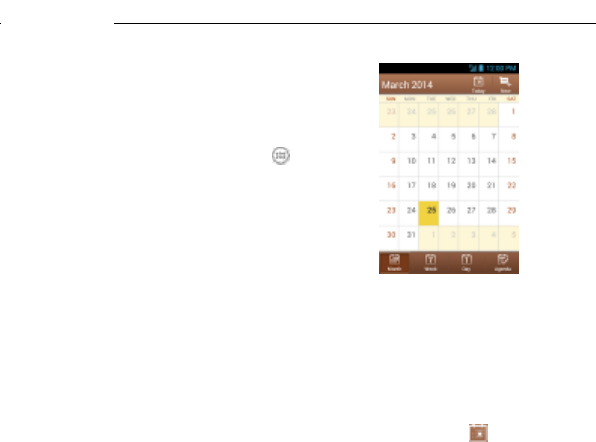
Calendar
46
Calendar on the phone works with the
web-based Google Calendar service for
creating and managing events, meetings, and
appointments. It also works with the Microsoft
Exchange ActiveSync calendar once you sign
into your Exchange account on the phone.
To open Calendar, press the Home Key >
and select Calendar.
Viewing Your Calendars and
Events
Selecting Visible Calendars
1. Open the Calendar app.
2. Press the Menu Key > Calendars to
display.
3. In the new screen, tap the calendars to
check the calendars you want to see or
uncheck the calendars you’d like to hide.
Events from hidden calendars are not shown
in the Calendar app.
Changing Calendar Views
You can view your calendars in different forms.
The app offers four views: Month, Week, Day,
and Agenda.
To change calendar views, tap the time period
shown at the bottom and select the view you
prefer.
You can also change to Day view from Month
view by tapping any day in the grid.
TIPS:
• In Month view, swipe vertically to see
earlier months and later months.
• In Week or Day view, swipe horizontally to
see earlier weeks/days and later
weeks/days.
• When you are viewing earlier or later days,
weeks, or months, tap at the top to
quickly switch to today.
Viewing Event Details
In Agenda, Day, or Week view, tap an event to
view its details.
In Month view, tap a day to switch to Day view.
Then tap an event to view its details.
Calendar

Calendar
47
Creating an Event
1. In any Calendar view, tap at the upper
right corner to open an event details screen
for a new event.
You can also tap a spot in Day or Week view
twice to add an event to that time spot.
2. Add details about the event.
Enter a name, location, time span, and other
additional details about the event.
NOTE: If you have more than one calendar,
you can choose the calendar to which to add
the event by tapping the current calendar
above the Event name box.
3. Tap DONE at the top of the screen to save
the new event.
Editing or Deleting an Event
1. Find the event you want to edit or delete.
2. Open its details screen (see Viewing Your
Calendars and Events – View Event
Details).
3. Choose one of the following options:
• To edit the event, tap at the bottom of
the screen. Tap DONE to save your
changes.
• To delete the event, tap at the bottom
of the screen and then tap OK.
Changing Calendar Settings
To change Calendar settings, open a Calendar
view (Day, Week, Month, or Agenda) and then
press the Menu Key > Settings.
You can change General settings, which apply
to all accounts, or other settings that only
apply to specific accounts.

Google talk
48
Google Talk is Google’s instant messaging
service. You can use it to communicate in real
time with other people who also use Google
Talk on a phone, on the web, or with a desktop
application.
Signing In to See Your Friends
You must sign in to your Google account
before you can use Google Talk.
Press the Home Key > and select Talk.
The first time you launch Talk, tap the account
you want to sign in with. Your friends list is
then displayed.
NOTE: You remain signed in to Google Talk
after launching the Talk app even if you switch
to other apps, until you explicitly sign out. To
sign out, go
back to your friends list and press the Menu
Key > Sign out.
Adding a Friend
1. In the friends list, tap at the top right of
the screen.
2. Enter your friend’s address and tap DONE.
Your friend’s address in Google Talk is a
Gmail or
other email address that is configured to
connect to Google Talk.
NOTE: If other people try to add you as a
friend, you will receive a notification in the
status bar and the invitation appears in your
friends list. You can tap the invitation to accept,
decline, or block.
Changing Your Online Status
1. Tap your own entry at the top of your friends
list.
2. In the screen that opens, tap your current
status to change it (or to sign out of Talk).
3. Enter a status message, or if you already
have one, edit it. In addition to the standard
status settings, you can also tap Change to
a recently-used status to select a message
that you’ve entered previously.
4. Press the Back Key to return to your friends
list.
Chatting With Friends
1. Tap a friend in your friends list. The chat
screen for that friend opens.
2. Type in a message and tap . You can
also tap to initiate a voice chat if the
friend is online.
Switching Between Active Chats
If you have more than one chat going, you can
switch between these chats in one of the
Google talk

Google talk
49
following ways:
• Press the Back Key to return from one
chat to the friends list. Then tap the other
friend you want to chat with.
• While you are in one chat screen with a
friend, swipe left or right to switch to the
chat screen with the other friend.
Using Group Chat
When you’re chatting, you can invite additional
friends to join a group chat.
1. On a chat screen, press the Menu Key >
Add
to chat.
2. Tap the name of the friend to invite.
The friend you invited and the current
participants receive an invitation to a group
chat. Each one who accepts the invitation joins
the group chat. In a group chat, everyone can
see everyone else’s messages. Group chats
appear at the top of your friends list with a
group chat icon.
Ending the Chat
While on a chat screen, press the Menu Key >
End chat.
You can also press the Menu Key > End all
chats while in the friends list to end all active
chats.
Changing Google Talk Settings
On any chat screen or in the friends list, press
the Menu Key > Settings to change Google
Talk settings for your account.

Google+
50
Google+ is a social networking service offered
by Google. The Google+ application on your
phone enables you to manage your data, chat
with online contacts, organize them in different
circles, and share your selected information.
Press the Home Key > and select
Google+. The first time you open the Google+
app, select the instant upload and contact
sync options.
Organizing Your Contacts
1. Open the Google+ app.
2. Tap > Circles.
3. Enter the person you want to search for or
select a suggested person, and tap Add.
4. Check the circles you want the person to be
added to, or tap Create a new circle.
Getting Updates
1. Open the Google+ app.
2. Tap > Home.
3. Swipe up or down to see different
information shared with you by other users.
Tap to choose what groups of
information are shown.
• Nearby shows posts shared with you by
users near your current location.
• All circles, Acquaintances, Family,
Following, and Friends show updates
from people you’ve added to your circles.
• What’s hot shows popular posts on
Google+.
Chatting With Contacts
You can chat with your Google+ contacts
through instant messaging, similar to sending
a text with the Messaging app.
1. Tap > Messenger in the Google+ app.
2. Tap to create a new message.
3. If you tapped at the top, tap to add
recipients. They can be contacts or circles.
4. Enter the message.
5. Tap to send the message.
TIP: Tap > Hangouts to hold a video chat
with your friends.
Checking Photos
You can see your own photo albums and
those shared by other users.
Tap > My photos in the Google+ app to
see all available albums.
Checking and Managing
Your Profile
1. Tap > Profile in the Google+ app.
2. Swipe up or down to see your posts and
personal info.
Google+

Google+
51
Tap and you can change your profile
photo.

Browser
52
Use Browser to view web pages and search
for information.
Opening the Browser
Press the Home Key > . The last web page
you were viewing is displayed. If you have not
used Browser recently, your home page
opens.
Browser also opens when you tap a web link—
for example, in an email or a text message.
Opening a Web Page or Searching the
Web
1. Open the Browser app.
2. Tap the address box at the top of the web
page. If the address box isn’t visible, swipe
down a little to show it.
3. Enter the address (URL) of a web page. Or,
enter terms you want to search for. You can
also tap to search by voice.
4. Tap a URL or search suggestion or tap Go
on the keyboard to open the web page or
search results.
TIP: Tap the X at the bottom of the screen if
you want to stop opening the page.
Setting the Homepage
Your home page opens when you open a new
browser tab, when you start Browser after
restarting your phone, or after not using the
app for a while.
1. Open the page you want to set as your
home page.
2. Press the Menu Key > Settings > General >
Set homepage.
3. Tap Current page or one of the following
options:
• Blank page: Open browser tab without
opening a web page by default. This can
make new Browser tabs open more
quickly.
• Default page: Set the factory default URL
as the homepage.
• Most visited sites: Every new browser tab
displays a list of your frequently visited
sites for you to choose from.
• Site Navigation: Provide a series of sites
for you to view.
• Other: Type a URL as the homepage.
Get Information About the
Current Page
Press the Menu Key > Page info.
Working With an Opened Page
While viewing most web pages, you can do the
following operations:
• Scroll: Swipe the screen in any direction.
Browser

Browser
53
• Zoom out: Tap the screen with two fingers
and pinch them together.
• Zoom in: Tap the screen with two fingers
and spread them apart.
• Go back: Tap at the bottom to return
to the page you’ve viewed previously in the
same window.
• Go forward: Tap at the bottom.
• Refresh the page: Tap beside the
address bar.
• Find text on the page: Press the Menu
Key >
Find on page and type the terms you want
to search for.
• Send the page URL to friends: Press the
Menu Key > Share page and select how
you want to send the URL.
• Follow a link: Tap a link on the web page
to open it.
• Save the page for offline reading: Press
the Menu Key > Save for offline reading.
You can press the Menu Key >
Bookmarks > SAVED PAGES to read
them.
TIPS:
• Some web sites may redirect you to the
mobile version of their web pages, which
mostly do not support scrolling or zooming.
If you want to view the desktop version,
press the Menu Key and check Request
desktop site.
• Besides links, Browser also recognizes
some phone numbers, addresses, and
similar information for you to act on. Try
tapping them and see what happens.
Using Multiple Browser Tabs
You can open several web pages at the same
time (one page in each tab) and switch
between them freely.
Opening a New Browser Tab
Tap at the bottom of the screen. A new
browser window opens and the homepage is
loaded.
Switching Between Tabs
1. Tap at the bottom of the screen.
2. Swipe vertically to scroll through the list of
opened tabs.
3. Tap the thumbnail of the tab you want to
open.
TIP: Swipe a thumbnail horizontally or tap its X
to close the tab.
Downloading Files
Tap and hold an image or a link to a file or to
another webpage. In the menu that opens, tap
Save image or Save link.
The downloaded files are saved to your phone

Browser
54
or the memory card. You can view or open
them in the Downloads app ( >
Downloads).
Using Bookmarks
Save web URLs as bookmarks to open them
easily in the future.
To open a bookmark, press the Menu Key >
Bookmarks in a browser tab and then tap the
bookmark.
Bookmarking a Web Page
1. Open the web page.
2. Press the Menu Key > Save to
bookmarks.
3. Edit the bookmark label and address if
necessary, or choose a different account.
Tap the name beside Add to to change the
place where the bookmark will be stored.
4. Tap OK.
Editing a Bookmark
1. Press the Menu Key > Bookmarks.
2. Tap and hold the bookmark to edit.
3. Tap Edit bookmark.
4. Edit the label, address, account, or location
of the bookmark in the dialog that opens.
5. Tap OK.
NOTE: Preinstalled bookmarks may not be
edited.
Deleting a Bookmark
1. Press the Menu Key > Bookmarks.
2. Tap and hold the bookmark to delete.
3. Tap Delete bookmark.
4. Tap OK.
NOTE: Preinstalled bookmarks may not be
deleted.
Viewing Your Browsing
History
1. Open the Browser app and press the Menu
Key > Bookmarks.
2. Tap the HISTORY tab.
3. Tap a time span to view the web pages you
browsed during that time. You can tap an
item to reopen the web page.
Changing Browser Settings
You can configure a number of Browser
settings to customize the way you browse the
web, including several that you can use to
control your privacy.

Browser
55
To open the Browser settings screen, press
the Menu Key > Settings.

Maps, Navigation, Local, and Latitude
56
Activating Location Services
To use Navigation, Local, and Latitude, and to
find your location on Google Maps, you must
have location services turned on on your
phone.
1. Press the Home Key > Menu Key > System
settings > Location services.
2. Select the location options you want to use.
Check Google’s location service to use
Wi-Fi and mobile networks to determine your
approximate location; check GPS satellites to
use GPS satellites to determine your location;
check Location & Google search to use your
location to improve search results and other
services.
Getting Your Location
1. Press the Home Key > and select
Maps.
2. Tap at the top right.
The map centers on a blue blinking dot that
indicates your location.
Searching for a Location
1. Press the Home Key > and select
Maps.
2. Tap .
3. Enter the place you’re looking for in the
search box at the top. You can enter an
address, a city, or a type of business or
establishment, for example, “museums in
Shanghai.” As you enter information,
suggestions from your previous searches
and from popular searches appear in a list
below the search box. You can tap a
suggestion to search for it.
TIP: You can also tap beside the search
box to use voice search.
4. Tap the search icon on the keyboard.
Markers
with letter labels indicating search results
appear on the map.
5. Tap a marker to open a balloon that
contains a label with summary information
about the location.
6. Tap the balloon to open a screen with more
information, as well as options for obtaining
directions and more.
Getting Directions to Your
Destination
Maps can provide directions for travel by foot,
public transportation, or car.
1. Press the Home Key > and select
Maps.
2. Tap at the bottom.
Maps, navigation, Local, and Latitude

Maps, Navigation, Local, and Latitude
57
3. Enter a start and end point and select the
mode of transportation (car, public transit,
bicycle, or walking). If you have enabled My
Location, this will appear in the start point
field by default.
4. Tap GET DIRECTIONS. The directions to
your destination are marked on the map.
Tap the left or right arrow to see the
directions step by step. You can also tap
DIRECTIONS LIST to see your route
displayed in a list.
NOTE: Press the Home Key > and select
Navigation to use Google Maps Navigation
and get turn-by-turn voice directions.
Searching for Local Places
Google Places helps you find all kinds of
businesses and establishments around you.
You can rate these places and get
recommendations
1. Press the Home Key > and select
Local. Or, from the Maps app, tap at
the top of the screen and select Local.
2. Wait while you are being located. Your
location, when found, is shown at the top.
3. Select a place category and the information
for that type of place near you will be
displayed.
You can also use the button at the
top to find the place you need.
NOTE: Press the Menu Key > Add a search
to add new place categories.
4. Tap a result you are interested in and check
out the details and reviews about that place.
You can also see the place on Maps, find
out how to get there, give that place a call,
add your rating and review, and more.
Sharing Location
Google Latitude lets you and your friends view
each other’s locations on maps and share
status messages.
1. Press the Home Key > and select
Maps.
2. Tap > Latitude. You will be prompted to
enable location reporting on your device.
Tap the prompt and check Report from this
device.
3. Press the Back Key.
After you join in, you can always tap at the
top in Maps and select Latitude to see your
status as well as that of your selected friends.
In Latitude, you can do the following:
• Tap to refresh friends’ status.
• Tap MAP VIEW to see friends on Maps.
You can tap the left/right arrow to switch
between each friends and yourself.

Maps, Navigation, Local, and Latitude
58
• Tap to add new friends to Latitude from
contacts, via email addresses, or from
suggested friends.
• Press the Menu Key to show or hide
“stale”
friends who haven’t updated their location
with
you for a while.
• Press the Menu Key > Location Settings
to change Latitude settings or sign out of
Latitude.

Google Search and Voice Search
59
You can search for information on the web or
on your phone using Google Search. You can
also search the web or perform certain tasks
by speaking.
Searching With Text
1. Tap the Google Search box at the top of the
Home Screen to start the Search app.
2. Enter the terms you want to search for and
tap , or tap a search suggestion.
Searching by Speaking
1. Tap the microphone icon to the right of the
search box.
2. Speak the terms you want to search for.
When you’re finished speaking, your speech
is analyzed and the search is initiated.
If Google Search didn’t quite understand what
you said, you are presented with a list of
similar-sounding terms. Tap the correct term to
start the search.
Changing Search and Voice
Search Settings
Open the Search app and press the Menu
Key > Settings to set searchable items.
To set Voice Search settings, press the Menu
Key > System settings > Language & input >
Voice Search.
Google Search Voice Search
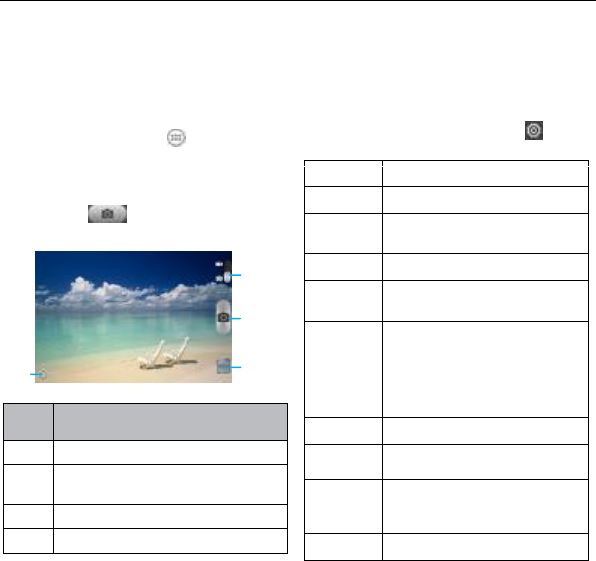
Camera
60
You can take photos and record videos.
Photos and videos are stored to the phone’s
memory card or to the phone’s internal storage.
You can copy them to your computer or
access them in the Gallery app.
Capturing a Photo
1. Press the Home Key > and select
Camera.
2. Aim the camera at the subject and make any
necessary adjustments.
3. Lightly tap or press the Camera
Key.
Numb
er
Function
1
Change the camera settings.
2
View the photos and videos you have
captured.
3
Capture a photo.
4
Switch to the camcorder.
Customize Camera Settings
Before taking a photo, you can tap to
open the following camera setting options:
Grid
Turn on/off grid.
Self-timer
Set the time to shutter automatically
Shutter
Tones
Select your preferred shutter tone.
Picture Size
Adjust picture size.
Image
settings
Adjust exposure, brightness,
contrast, saturation, and sharpness.
White
Balance
Select how the camera adjusts colors
in different kinds of light to achieve
the most natural looking colors for
your shots, or allow the camera to
adjust the white balance
automatically.
ISO
Adjust the ISO.
Anti-band
Change the lighting frequency
Geo-tag
Set whether your location information
is stored or not with each photo you
take.
Restore
Restore camera to default settings.
①
②
③
④
Camera
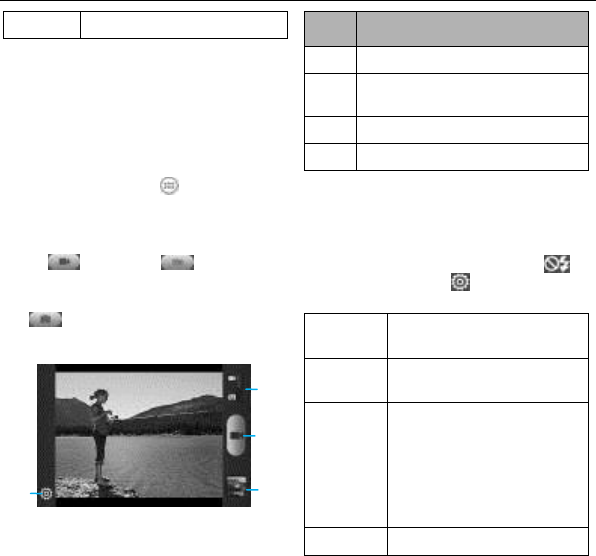
Camera
61
Defaults
Recording a Video
1. Press the Home Key > and select
Camera.
2. Switch to the camcorder mode.
3. Aim the camera at the subject and make any
necessary adjustments.
4. Tap to start and to stop
recording. You can also press the Camera
Key to start and stop.
TIP: While recording is in progress, you can
tap to save the frame as a photo.
Numb
er
Function
1
Change the camcorder settings
2
View photos and videos you have
captured.
3
Start or stop recording a video.
4
Switch to the camera.
Customizing Camcorder
Before recording a video, you can tap to
turn on the flash or tap to open the
following camcorder setting options:
Video
Quality
Adjust video quality.
Time
Lapse
Adjust the time lapse.
White
Balance
Select how the camera adjusts
colors in different kinds of light
to achieve the most natural
looking colors for your videos,
or allow the camera to adjust
the white balance
automatically.
Geo-tag
Set whether your location
①
②
③
④

Camera
62
information is stored or not
with each video you record.
Silent
camcorder
Only record video without
sound
Restore
Defaults
Restore default settings.
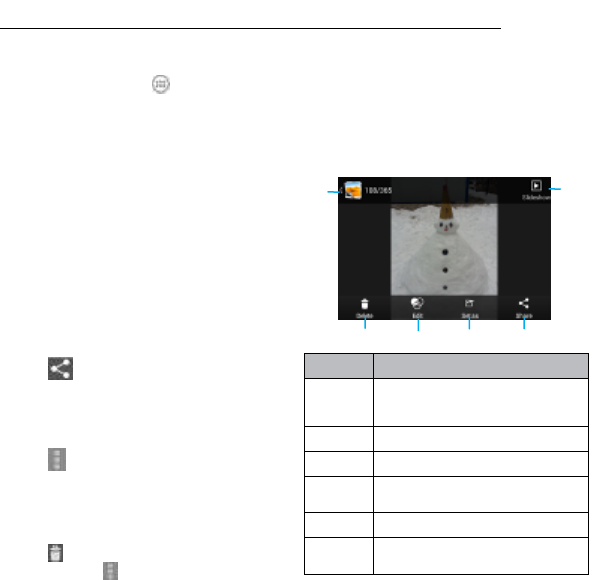
Gallery
63
Opening the Gallery
Press the Home Key > and select Gallery
to view albums of your pictures and videos.
Working With Albums
When you open the Gallery, all pictures and
videos on your phone are displayed in a
number of albums.
Viewing album contents
Tap an album to view the pictures and videos
it contains.
Sharing Albums
1. Tap and hold an album until it is selected.
2. Tap more albums that you want to share.
3. Tap at the top of the screen and select
how you want to share the albums.
Viewing Details of an Album
1. Tap and hold an album until it is selected.
2. Tap > Details.
Deleting Albums
1. Tap and hold an album until it is selected.
2. Tap more albums that you want to delete.
3. Tap > Delete. If only one album is
selected, tap > Delete > OK.
Working With Pictures
Tap a picture in an album to view the picture in
full screen. Double-tap the picture, or pinch
two fingers together or spread them apart to
zoom out or in. Slide left or right to view other
pictures in the album.
Number
Function
1
Tap to return to the album, where
all its contents are displayed in a
grid.
2
Delete the picture.
3
Edit the picture.
4
Set the picture as wallpaper or
contact photo
5
Share the picture
6
Display the pictures as
slidershow
①
⑥
Gallery
②
③
④
⑤
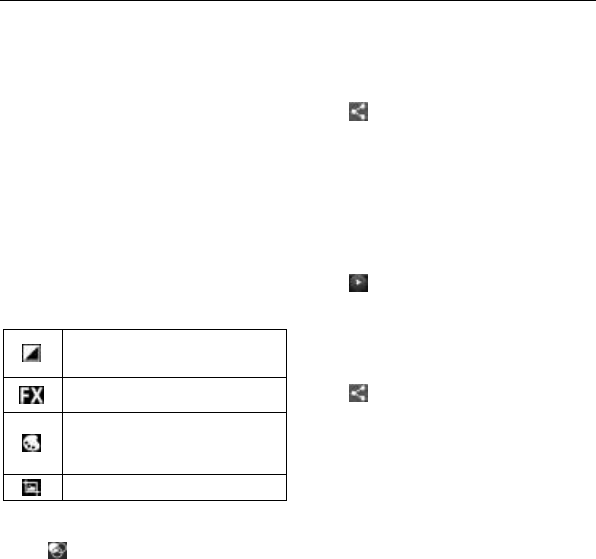
Gallery
64
Press the Menu Key to browse the album
contents in a slideshow, rotate the picture,
view picture details, set it as contact icon or
wallpaper, or edit it.
NOTE: Not all the options may be available for
certain albums or pictures.
Retouching Your Pictures
You can edit any photos you took and some
other pictures in Gallery. The changed picture
is saved in the Edited album, while the original
image is never affected.
1. Press the Menu Key > Edit while viewing a
picture in full screen to open the edit
interface.
2. Tap the icons along the bottom of the screen
to edit the picture.
Apply effects such as posterizing,
lomography, documentary, film
grain, and more
Apply modification as Crop,
Straighten,Mirror, Rotate..
Apply Auto adjust, Exposure,
Vignette, B/W, Shadows, Vibrance,
Sharpness, Curves, Hue,
Saturation
Apply boder and bright styles.
3. To undo or redo the changes you’ve made
to the picture, tap at the top of the screen.
4. Tap to save the new picture to the
Edited album.
Sharing Your Pictures
1. Tap an album in Gallery and then tap a
picture.
2. Tap at the top of the screen. If the icon
is invisible, tap the screen first.
3. Select how you want to share the picture.
Working With Videos
Playing Videos
1. Tap an album in Gallery and then tap the
thumbnail of a video.
2. Tap at the center to start playing.
3. Tap the video to view the playback controls.
Sharing Videos
1. Tap an album in Gallery and then tap the
thumbnail of a video.
2. Tap at the top of the screen. If the icon
is invisible, tap the screen first.
3. Select how you want to share the video.

Music
65
Press the Home Key > and select Music
to play audio files stored on your phone. Music
supports a wide variety of audio formats, so it
can play music you purchase from online
stores, music you copy from your CD
collection, and so on.
Copying Music Files to Your
Phone
Before using Music, you need to copy audio
files from your computer to your phone’s
memory card.
Copying From a Computer
1. Connect your phone and the computer with
a
USB cable.
2. Tap Media device (MTP) (if supported on
the PC) or Camera (PTP) to browse the files
on the phone storage and the microSDHC
card.
3. Copy the music file from the PC to the
phone storage or microSDHC card.
Downloading From the Internet
You can download music files when browsing
web pages. (See Browser – Downloading
Files.)
Receiving via Bluetooth
You can receive music files from other devices
via Bluetooth. (See Connecting to Networks
and Devices – Receiving Data via Bluetooth.)
Viewing Your Music Library
Press the Home Key > and select Music
and your music library is displayed. All your
audio files are cataloged according to the
information stored in the files.
Tap the tabs at the top of the screen to view
your music library organized by Albums,
Artists, Songs, Playlists, Folders, or Genre
Lists.
NOTE: If an audio file is being played, its
summary information is displayed at the
bottom of the screen. Tap the song to open the
playback screen.
Setting a Song as the Default Ringtone
The song will be used as the ringtone for all
incoming calls, except those from contacts you
have assigned special ringtones to (see
People – Editing Contacts – Setting a
Ringtone for a Contact).
1. Press the Home Key > and select
Music to see the music library.
2. Tap next to a song in any list.
3. In the menu that opens, tap Use as phone
ringtone.
TIP: If the song is being played, you can press
the Menu Key > Use as ringtone in the
Music
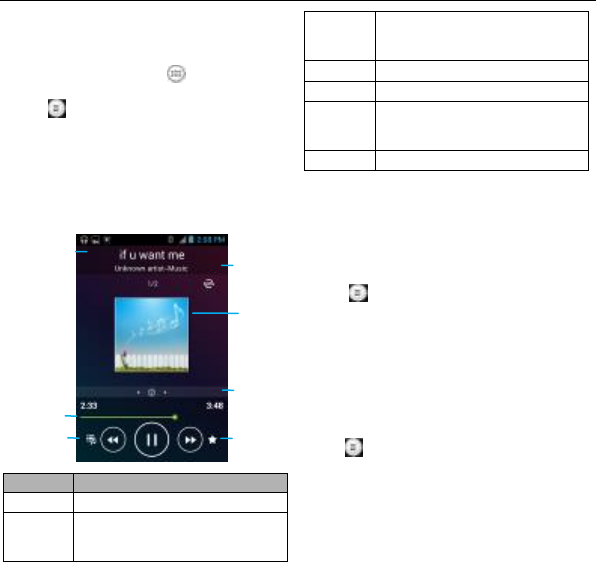
Music
66
playback screen
Deleting a Song
1. Press the Home Key > and select
Music to see the music library.
2. Tap next to a song in any list.
3. In the menu that opens, tap Delete > OK.
Playing Music
Tap a song in the music library to listen to it.
The following playback screen appears:
Number
Function
1
Song and artist information.
2
Tap to toggle repeat mode (no repeat,
repeat the current song, or repeat the
current playlist).
3
Playback control. Skip songs or pause
and resume playback. Drag the slider to
jump to any part of the song.
4
Tap to open the current playlist.
5
Tap to add a song to the favorite list.
6
Tap to play the current playlist in shuffle
mode, where tracks are played in
random order.
7
Album artwork.
Managing Playlists
Create playlists to organize your music files
into sets of songs, so that you can play the
songs you like in the order you prefer.
Creating a Playlist
1. Tap next to the song in the music
library.
2. In the menu that opens, tap Add to playlist.
3. Tap New.
4. Type the playlist name and tap Save.
The playlist is created and the song you
selected is added to the playlist.
Adding a Song to a Playlist
1. Tap next to the song in the music
library.
2. In the menu that opens, tap Add to playlist.
3. Tap the name of the playlist you want the
song added to.
Removing a Song From a Playlist
①
④
③
⑤
②
⑥
⑦

Music
67
1. Open a playlist.
2. Tap and hold the song or songs you want to
remove.
3. Tap > OK.
Deleting or Renaming a Playlist
1. Tap the Playlists tab in the music library to
see all the playlists.
2. Tap next to a playlist and tap Rename
Playlist or Delete Playlist in the menu that
opens.
NOTE: These options may not be available for
certain automatically created playlists, such as
Recently added.
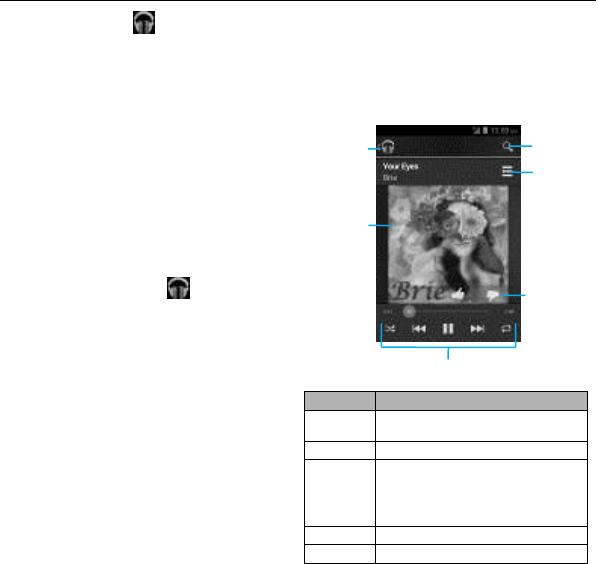
Play Music
68
The Play Music app works with Google
Music, Google’s online music store and
streaming service. You can stream via mobile
data or Wi-Fi and listen to your favorite songs
that you’ve added to your online Google Music
library. You can also play audio files you’ve
copied directly to your phone from a computer.
NOTE: The availability of Google Music is
dependent on your region. If it is not available,
or you don’t have a mobile data or Wi-Fi
connection, you can only play music stored on
your phone.
Playing Your Music
1. Press the Home Key > . If you are
prompted, select an account to access its
online music library.
The app searches your online library and
your phone for music and playlists before
displaying your combined music library,
organized by Recent, Artists, Albums,
Songs, Playlists, and Genres.To change
views of your library, swipe left or right when
holding the phone upright, or tap the view
name at the top left of the screen when
holding the phone on its side.
2. Tap a song to play it. When the song is
playing, tap the album artwork to display
more options.
Number
Function
1
Tap to view the currently playing
list.
2
Album artwork.
3
Playback control. Skip songs,
pause and resume playback, use
shuffle or repeat. Drag the
progress bar to jump to any part
of the song.
4
Rate the song.
5
Go back to now playing list.
③
①
②
④
⑤
⑥
Play Music

Play Music
69
6
Search for music.

Play Music
70
You can still control the music when you are
not in the playback screen.
• In the Play Music app, tap the Now
Playing bar at the bottom (portrait mode) of
the screen to restore the playback screen.
• In other apps, flick down on the notification
panel. Tap the song title to restore the
playback screen, or just pause/resume
playback or skip to the next/previous song.
• When the screen is locked, the song
information and playback controls are
displayed on top of the screen. You can
pause/resume playback or skip songs.
Managing Playlists
Create playlists to organize your music files
into sets of songs so that you can play the
songs you like in the order you prefer.
Create a Playlist or Add a Song to a
Playlist
Tap and hold the song or tap next to the
song, and select Add to playlist.
Rearranging Songs in a Playlist
1. Open a playlist in the Playlists tab of the
music library.
2. Tap and hold the small grid in front of a
song.
3. Drag the grid up or down to change its order
in
the playlist.
Removing Songs From a Playlist
1. Open the playlist in the Playlists tab of the
music library.
2. Tap and hold the song or tap next to the
song you want to remove.
3. Select Remove from playlist.
Renaming or Deleting a Playlist
1. Swipe to the Playlists tab in the music
library to see all the playlists.
2. Tap and hold a playlist or tap next to
the playlist.
3. Tap Rename or Delete in the menu that
opens.

Video Player
71
Use the Video Player to play various kinds of
videos.
Opening the Video Library
Press the Home Key > and select Video
Player
to view your video library.
Tap the tabs at the top of the screen to view
the available videos.
• ALL: Videos on your phone.
• LAST ADDED: Recently added videos on
your phone.
• CAMERA VIDEOS: Videos you have
recorded with the phone’s camera.
Playing and Controlling Videos
• Tap a video in the video library to play it.
Rotate the phone on its side to watch the
video in landscape view.
• Tap the video to show the playback
controls. You can pause and resume the
playback or jump to any part of the video.
You can also exit the video by pressing the
Back Key.
Managing Video Files
Deleting Videos
1. Tap and hold a video in the video library.
The video
is highlighted.
2. To remove more videos, tap them.
3. Tap at the bottom left of the screen.
4. Tap OK.
Sharing Videos
1. Tap and hold a video in the video library.
The video
is highlighted.
2. To share more videos, tap them.
3. Tap at the bottom right of the screen
and select how you want to share them.
Renaming a Video
1. Tap next to the video you want to
rename.
2. Tap Rename.
3. Type the new video name and tap OK.
Viewing Details of a Video
1. Tap next to a video.
2. Tap Details.
Video Player

Sound Recorder
72
Sound Recorder enables you to record voice
memos and listen to them whenever you like.
Recording a Voice Memo
1. Press the Home Key > and select
Sound Recorder.
2. Tap to start recording. Tap > OK to
cancel recording if you change your mind.
3. Tap to stop recording. The memo is
automatically saved.
If you don’t want to save the memo after
recording it, tap > OK to delete it.
Playing a Voice Memo
Playing a Memo You Just Recorded
Tap at the bottom of the screen.
Playing Any Saved Memo
1. Tap at the top right of the screen to see
all recordings.
2. Tap the title of a memo to play it.
NOTE: You can also tap at the right of the
memo to share, rename, delete it, check its file
information, or set it as your phone ringtone.
Sound Recorder

More Apps
73
Alarm
Set alarms or turn the phone into a bedside
clock.
Setting a New Alarm
1. Press the Home Key > and select
Alarm.
2. Tap a default alarm to configure it, or tap
Add alarm at the bottom of the screen to
create a
new alarm.
3. Set up the alarm options, such as time,
repeat,
and ringtone.
4. Tap SAVE to save and exit.
Using the Bed Clock
The Bed Clock displays the current time and
the
next alarm.
1. Press the Home Key > and select
Alarm.
2. If necessary, press the Menu Key > Bed
Clock Preferences in the Alarm screen to
set up the Bed Clock options. Then press
the Back Key to return to the Alarm screen.
• Enable bed clock: Turn on or off the Bed
Clock function.
• Bed clock never sleeps: Keep the Bed
Clock screen turned on when charging the
phone.
3. Press the Menu Key > Bed Clock to open
the Bed Clock screen.
Calculator
Press the Home Key > and select
Calculator.
TIP: Tap or , or swipe left or right to
switch between different panels. You can also
hold the phone on its side to see all of the
calculator buttons.
Downloads
The Downloads app keeps a record of the files
you have downloaded using the Browser,
Email, or Gmail app.
Press the Home Key > and select
Downloads to check the record.
• Tap a file to open it with the appropriate
applications.
• Tap and hold a file, or check the box in front
of it, to delete or share it.
File Manager
Quickly access all of your images, videos,
More Apps

More Apps
74
audio clips, and other types of files on your
phone and on the memory card.
1. Press the Home Key > and select File
Manager.
2. Tap the folder name at the top of the screen
to switch between the memory card storage
and the phone storage.
Full Share
Full Share offers a wireless solution to sharing
media files among devices connected to the
same Wi-Fi network. You can use this feature
to easily access media content on different
devices without having to transfer files.
Sharing Media Files on Your Phone
1. Connect your phone to a Wi-Fi network.
2. Press the Home Key > and select Full
Share.
3. Tap Menu > Settings and check or uncheck
Share music, Share videos, or Share
images. Only checked types of files will be
shared.
4. Turn Allow media sharing to ON.
Now your phone works as a media server and
you can access the shared files from other
devices that support Full Share and are
connected to the same Wi-Fi network as your
phone.
Accessing Shared Files on
Other Devices
After another device has shared its media
contents while connected to a Wi-Fi network,
you can access them with your phone.
1. Connect your phone to the same Wi-Fi
network as the other device.
2. Press the Home Key > and select Full
Share.
3. Tap the Server List tab. The other device
should appear in this tab.
4. Tap the device and select a category to
access
its contents.
5. Tap a file (and select a media render if
prompted) to start playing it with the
dedicated player for shared media contents.
You can also press the Menu Key >
Multi-Select to select multiple items and then
tap the following buttons:
• Tap (and select a media render if
prompted)
to play the selected files on the media
render one by one.
• Tap to add the files to the playlist. You
can access them in the Playlist tab.
• Tap to download the files to the local
device from a media server within the

More Apps
75
network.
• Tap to upload the files to another media
server within the network.
Note Pad
Press the Home Key > and select Note
pad to save and view your text notes.
• Tap New to create a new note. Then enter
your text and tap Save to save it.
• Tap a note to view its entire content. You
can also delete it, share it, or export it.
Play Books
Press the Home Key > and select Play
Books to read ebooks purchased from Play
Store.
• Tap a book cover displayed in Play Books
to start reading it. You can also tap the
shopping bag icon at the top to buy more
books from Play Store or tap to search by
book title or author name.
Play Movies & TV
Press the Home Key > and select Play
Movies & TV to watch movies you rent from
Play Store as well as your personal videos
stored on the phone.
• The MY RENTALS tab displays your
recent movie rentals. You can stream them
for online watching or download them to
watch offline.
• The PERSONAL VIDEOS tab displays
videos from other sources. Tap a video to
play it.
Task Manager
Press the Home Key > and select Task
Manager to view or stop applications.
• Tap a task in the Tasks tab to switch to its
screen, force stop it, or see its details.
• Tap the Apps tab to manage all the apps
on
your phone.
• Tap the Resources tab to view the
real-time
system resources information.
Timer
Press the Home Key > and select Timer
to use the stopwatch or the timer.
Stopwatch allows you to record lap times,
while Countdown allows you to set a time and
count down to zero.
World Time
Press the Home Key > and select World

More Apps
76
time to check local time for cities around the
world.
• Tap at the bottom to add a new city or
country.
YouTube
Press the Home Key > and select
YouTube.
You can watch YouTube videos or upload your
own.

Play Store
77
Press the Home Key > . You can buy or rent
music, books, movies, and apps and download
them
to your phone.
NOTE: The content you can access in Play
Store depends on your region and your
service provider.
Browsing and Searching for
Apps
You can browse apps by category and sort
them in different ways. Tap a top-level
category, such as Games, and tap the app
from any subcategory.
You can also search for apps using an app’s
name or description, or the developer’s name.
Just tap and enter the search terms.
Downloading and Installing
Apps
When you find the app you are interested in
through browsing or searching, tap it to open
its details screen, where more information
about the app is displayed.
1. Tap Download (free apps) or the price (paid
apps) in the app details screen.
2. If the app is not free, you will need to sign in
to your Google Wallet account and select a
payment method.
3. Tap Accept & download (free apps) or
Accept & buy (paid apps) to accept the
permissions for the app. Your app will start
downloading immediately or once payment
is successfully authorized.
Managing Your Downloads
After you’ve downloaded and installed an app,
you can rate it, view it in a list with your other
downloaded apps, configure it to update itself
automatically, and so on.
Viewing Your Downloaded
Apps
1. In the Apps screen of Play Store, press the
Menu Key > My Apps.
2. Your list of installed apps opens. You can
tap one to rate it, uninstall it, request a
refund, and so on.
Uninstalling an App
1. In the Apps screen of Play Store, press the
Menu Key > My Apps.
2. Tap an app to open its details screen.
3. Tap Uninstall > OK.
Play Store

Settings
78
Press the Home Key > and select
Settings. The Settings app contains most of
the tools for customizing and configuring your
device.
General Settings
Airplane Mode
Swipe the ON/OFF switch to turn on or off
airplane mode.
Wi-Fi
Turn Wi-Fi on or off and configure your Wi-Fi
connections. (See Connecting to Networks
and Devices – Connecting to Wi-Fi.)
Bluetooth
Turn Bluetooth on or off and configure your
Bluetooth connections. (See Connecting to
Networks and Devices – Connecting to
Bluetooth Devices.)
Mobile Networks
Control mobile data use and data roaming.
(See Connecting to Networks and Devices –
Connecting to Mobile Networks.)
Sound
Adjust volumes (see Personalizing – Adjusting
Volumes), toggle sound and mute (see
Personalizing – Switching to Silent Mode), set
up ringtone (see Personalizing – Changing the
Ringtone) and notification sound (see
Personalizing – Changing the Notification
Sound), and select system sounds (see
Personalizing – Turning On/Off Touch
Sounds).
Display
• Brightness: Set the brightness of the
display.
• Wallpaper: Select a background image for
the home screen.
• Sleep: Set the length of time of inactivity
before the screen turns off automatically.
• Font size: Set the font size of the text on
the screen.
• Pulse notification light: Flash the LED
light to notify you of missed calls, new
messages, and
other events.
Date and Time
Set the time zone, and how date and time are
displayed. You can also use network-provided
time zone.
Language and Input
• Language: Select a language and region
for
Settings

Settings
79
your system.
• Spell checker: Use Android spell checker
to check for spelling errors when entering
text.
• Personal dictionary: Add new words to the
phone’s dictionary or remove words from the
dictionary. The words you add are used for
spelling check and word suggestion.
• KEYBOARD & INPUT METHODS:
Configure text input settings. (See Knowing
the Basics – Entering Text – Touch Input
Settings.)
• Voice Search
– Language: Select the language you use
when entering text by speaking or searching
by speaking.
– Speech output: To turn on speech output only
when you’ve got a headset attached to your phone,
select Hands-free only.
– Block offensive words: Hide offensive words
when you use Google voice recognition to
transcribe your voice into text.
– Hotword detection: When this is checked, you
can say “Google” when viewing the Google Now
screen rather than touching the Microphone icon to
initiate a voice search or action.
• Text-to-speech output
– PREFERRED ENGINE: Select the speech
synthesis engine you want to use or change
its settings.
– Speech rate: Select how quickly you want the
synthesizer to speak.
– Listen to an example: Play a brief sample of the
speech synthesizer, using your current settings.
• Pointer speed: Select how fast the
pointer/mouse should scroll when you
connect the phone to a trackpad or mouse
accessory.
Wireless and Networks
Data Usage
Tap the ON/OFF switch to turn on or off mobile
data.
You can check how much data has been used
during the time circle you set, set mobile data
limit and warning, see what app has been
using mobile data, allow data roaming, or
restrict background data for individual apps.
NOTE: The data usage is measured by your
phone, and your carrier’s data usage
accounting may differ.
VPN
Set up and connect to virtual private networks.
(See Connecting to Networks and Devices –
Connecting to Virtual Private Networks.)
Device
Storage
Check memory information for your external
memory card and internal storage.

Settings
80
• Unmount SD card: Unmount the memory
card from your phone so that you can
safely remove
the card.
• Erase SD card: Erase all data on your
memory card and prepare it for use with
your phone.
Battery
Check how much power remains for the
battery and what has been using the battery.
Apps
See apps installed on your phone and manage
them.
Tap an app in the DOWNLOADED, ON SD
CARD, RUNNING, or ALL tab to see its
information. You can stop the app, uninstall or
disable the app, clear data and cache, or move
the app between the internal storage and the
memory card.
NOTE: Not all applications can be moved or
uninstalled.
Connect to PC
Select the USB connection mode between
your phone and PC. (See Connecting to
Networks and Devices – Connecting to Your
Computer via USB – Connect Your Phone to a
Computer via USB.)
Personal
Location Services
Activate location services to determine your
location. (See Maps, Navigation, Local, and
Latitude – Activating Location Services.)
Check Location & Google search to let
Google apps access your location and use
your location to improve search results and
other services.
Security
•Screen lock: Lock the screen with long press,
face unlock, pattern, PIN, or password.
(See Personalizing – Protecting Your
Phone With Screen Locks.)
• Owner info: Set the text that you may
display on the lock screen.
• Encrypt phone: Encrypt your data on the
phone to protect your privacy. (See
Personalizing – Protecting Your Phone
With Encryption.)
• Make pattern visible: Show the pattern as
you draw it.
• Device administrators: View or
deactivate apps you have authorized to be
device administrators.
• Unknown sources: Check this option to
permit installation of apps from sources

Settings
81
other than the Play Store.
• Verify apps: Disallow or warn before
installation of apps that may cause harm.
• Storage type: Software only
• Encrypt SD card: Check this option to
require a numeric PIN or password to
decrypt your microSDHC card each time
you power on your phone.
• Make passwords visible: Display
passwords as you enter them.
• Trusted credentials: Display trusted CA
certificates.
• Install from SD card: Install certificates
from the memory card.
• Clear credentials: Delete all certificates.
Backup and Reset
• Back up my data: Back up app data, Wi-Fi
passwords, and other settings to Google
servers after you sign in to your Google
account.
• Automatic restore: Restore previously
backed up settings and data when you
reinstall an app.
• Factory data reset: Reset your phone to
factory default settings. All your personal
data from the phone’s internal storage will
be erased. You can also erase the data on
the memory card during
the process.
Accounts
Manage your accounts and synchronization.
Tap
Add account to sign in to or create accounts
on
your phone.
Tap an account type to see that type of
accounts you have added and adjust the
accounts settings.
System
Accessibility
Configure the system accessibility options and
accessibility plug-ins on your phone, such as
using TalkBack for low-vision users.
Software Updates
Check for updates, software version and
Profile.
About Phone
View phone status, legal information, model
number, Android version, baseband version,
kernel version,,software version, hardware
version and frequency band.

Troubleshooting
82
If you encounter problems while using the phone, or if it performs abnormally, you can refer to
the chart below. If your particular problem cannot be resolved using the information in the chart,
contact the dealer where you purchased the phone.
Problem
Possible Causes
Possible Solution
Poor reception
The network signal is too weak at your
current location, for example, in a
basement or near a tall building,
because wireless transmissions can
not effectively reach it.
Move to a location where the network
signal can be properly received.
The network is busy at the current
time (for example, during peak times,
there may be too much network traffic
to handle additional calls).
Avoid using the phone at such times, or try
again after waiting a short time.
You are too far away from a base
station for your service provider.
You can request a service area map from
your service provider.
Echo or noise
Poor network link quality on the part of
your service provider.
End the call and dial again. You may be
switched to a better-quality network link or
phone line.
Poor local telephone line quality.
End the call and dial again. You may be
switched to a better-quality network link or
phone line.
Unable to
select certain
features
Your service provider does not
support these features, or you have
not applied for services that provide
these features.
Contact your service provider.
Battery not
charging
The battery or battery charger is
damaged.
Contact the dealer.
Troubleshooting

Troubleshooting
83
Problem
Possible Causes
Possible Solution
The phone’s temperature is below
32°F (0°C) or higher than 113°F
(45°C).
Adjust the battery charging environment to
avoid extremes of temperature.
Poor contact between the battery and
charger.
Check all connectors to make sure all
connections have been properly made.
Shortened
standby time
The standby time is related to your
service provider system configuration.
The same phone used with different
service providers’ systems will not
provide exactly the same length of
standby time.
If you are located in an area where
signaling is weak, temporarily power off
the phone.
The battery is depleted. In high
temperature environments, battery life
will be shortened.
Use a new battery.
If you are not able to connect to the
network, the phone will continue to
send out signals as it attempts to
locate a base station. Doing so
consumes battery power and will
consequently shorten standby time.
Change your location to one where the
network is accessible, or temporarily turn
off your phone.
Cannot turn
your phone on
Battery power has been depleted.
Recharge the phone’s battery.
Unable to
connect to the
network
You are not within the network’s
service area.
Check the service area with your service
provider.
You cannot
make outgoing
Poor signal.
Move to an open space, or if you are inside
a building, move closer to a window.

Troubleshooting
84
Problem
Possible Causes
Possible Solution
calls.
You have activated the Fixed dial
numbers feature.
Go to Call settings to check the Fixed
Dialing Numbers and disable it.
You have activated the Call barring
feature.
Upgrade the phone software.
PIN Code
blocked
You have entered an incorrect PIN
code three consecutive times.
Contact your service provider.
Unable to
enter
information
into the
phonebook
The phonebook’s memory is already
full.
Delete unnecessary data from the
contacts.
Phone
crashes,
reboots,
freeze, or
cannot be
powered on
Some third-party software is not
compatible with your phone.
Reset the phone to factory status.
Cannot answer
incoming calls
You have activated the Call barring
feature.
Enter safety mode and uninstall the
software that may cause the problem.
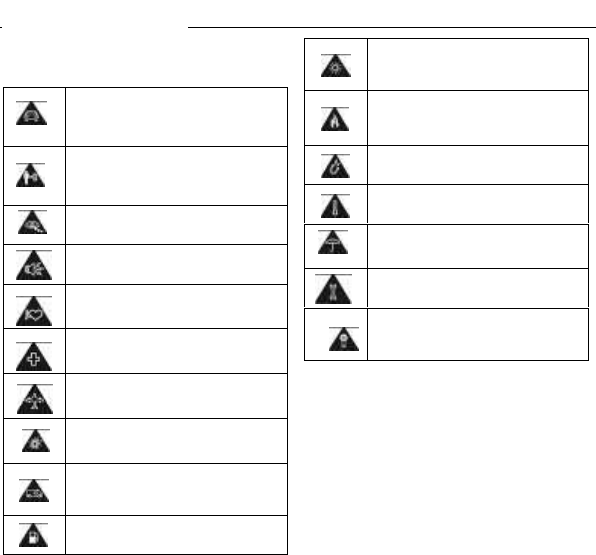
For Your Safety
85
General Safety
Don’t make or receive handheld calls
while driving. And never text while
driving.
Keep your phone at least 0.6 inches
(15mm) away from your ear or body
while making calls.
Small parts may cause choking.
Your phone can produce a loud sound.
Keep away from pacemakers and other
electronic medical devices.
Switch off when asked to in hospitals
and medical facilities.
Switch off when told to in aircrafts
and airports.
Switch off when near explosive materials
or liquids.
Don’t rely on your phone for emergency
communications.
Don’t use at gas stations.
Your phone may produce a bright or
flashing light.
Don’t dispose of your phone in fire.
Avoid contact with anything magnetic.
Avoid extreme temperatures.
Avoid contact with liquids. Keep your
phone dry.
Don’t take your phone apart.
Only use approved accessories.
For Your Safety

For Your Safety
86
Radio Frequency (RF) Energy
This model phone meets the government’s
requirements for exposure to radio waves.
This phone is designed and manufactured not to
exceed the emission limits for exposure to radio
frequency (RF) energy set by the Federal
Communications Commission of the U.S.
Government:
The exposure standard for wireless mobile
phones employs a unit of measurement known as
the Specific Absorption Rate, or SAR. The SAR
limit set by the FCC is 1.6W/kg. *Tests for SAR
are conducted using standard operating positions
accepted by the FCC with the phone transmitting
at its highest certified power level in all tested
frequency bands. Although the SAR is determined
at the highest certified power level, the actual SAR
level of the phone while operating can be well
below the maximum value. This is because the
phone is designed to operate at multiple power
levels so as to use only the power required to
reach the network. In general, the closer you are
to a wireless base station antenna, the lower the
power output.
The highest SAR values for this model phone as
reported to the FCC when tested for use at the ear
and on the body are:
Head: 1.40W/kg, Body: 1.01W/kg
(Body-worn measurements differ among phone
models, depending upon available enhancements
and FCC requirements.)
While there may be differences between the SAR
levels of various phones and at various positions,
they all meet the government requirement.
The FCC has granted an Equipment Authorization
for this model phone with all reported SAR levels
evaluated as in compliance with the FCC RF
exposure guidelines. SAR information on this
model phone is on file with the FCC and can be
found under the Display Grant section of
http://www.fcc.gov/oet/ea/fccid/ after searching
on FCC ID: SRQ-Z668C.
For body-worn operation, this phone has been
tested and meets the FCC RF exposure
guidelines for use with an accessory that contains
no metal and positions the handset a minimum of
0.6 inches (1.5 cm) from the body. Use of other
enhancements may not ensure compliance with
FCC RF exposure guidelines. If you do not use a
body-worn accessory and are not holding the
phone at the ear, position the handset a minimum
of 0.6 inches (1.5 cm) from your body when the
phone is switched on.
FCC Compliance
This device complies with part 15 of the FCC
Rules. Operation is subject to the following two
conditions:
(1) This device may not cause harmful
interference,
and (2) this device must accept any interference
received, including interference that may cause
undesired operation.
CAUTION: Changes or modifications not
expressly approved by the manufacturer could
void the user’s authority to operate the
equipment.

For Your Safety
87
NOTE: This equipment has been tested and
found to comply with the limits for a Class B
digital device, pursuant to part 15 of the FCC
Rules. These limits are designed to provide
reasonable protection against harmful
interference in a residential installation. This
equipment generates, uses and can radiate
radio frequency energy and, if not installed
and used in accordance with the instructions,
may cause harmful interference to radio
communications. However, there is no
guarantee that interference will not occur in a
particular installation. If this equipment does
cause harmful interference to radio or
television reception, which can be determined
by turning the equipment off and on, the user
is encouraged to try to correct the interference
by one or more of the following measures:
• Reorient or relocate the receiving antenna.
• Increase the separation between the
equipment
and receiver.
• Connect the equipment into an outlet on a
circuit different from that to which the
receiver
is connected.
• Consult the dealer or an experienced
radio/TV technician for help.
Using Your Phone with a
Hearing Aid Device
Your Z668C is compliant with the FCC
Hearing Aid Compatibility (HAC) requirements.
For additional HAC information, including the
HAC rating of this product, please refers to
www.zteusa-support.com.
In 2003, the FCC adopted rules to make digital
wireless telephones compatible with hearing
aids and cochlear implants. Although analog
wireless phones do not usually cause
interference with hearing aids or cochlear
implants, digital wireless phones sometimes
do because of electromagnetic energy emitted
by the phone's antenna, backlight, or other
components. Your phone is compliant with
FCC HAC regulations (ANSI C63.19- 2007).
When some wireless phones are used near
some hearing devices (hearing aids and
cochlear implants), users may detect a
buzzing, humming, or whining noise. Some
hearing devices are more immune than others
to this interference noise, and phones also
vary in the amount of interference they
generate. The wireless telephone industry has
developed ratings for some of their mobile
phones to assist hearing device users in
finding phones that may be compatible with
their hearing devices. Not all phones have
been rated. Phones that have been rated have

For Your Safety
88
a label on the box.
Your Z668C has been tested for hearing aid
device compatibility and has an M4/T4
rating.
These ratings are not guaranteed. Results will
vary, depending on the level of immunity of
your hearing device and the degree of your
hearing loss. If your hearing device happens to
be vulnerable to interference, you may not be
able to use a rated phone successfully. Trying
out the phone with your hearing device is the
best way to evaluate it for your personal
needs.
M-Ratings: Phones rated M3 or M4 meet FCC
requirements and are likely to generate less
interference with hearing devices than phones
that are not labeled. M4 is the better/higher of
the two ratings.
T-Ratings: Phones rated T3 or T4 meet FCC
requirements and are likely to be more usable
with a hearing device’s telecoil (“T Switch” or
“Telephone Switch”) than unrated phones. T4
is the better/higher of the two ratings. (Note
that not all hearing devices contain telecoils.)
The more immune your hearing aid device is,
the less likely you are to experience
interference noise from your wireless phone.
Hearing devices may also be measured for
immunity to this type of interference. Your
hearing device manufacturer or hearing health
professional may help you find results for your
hearing device.
For additional information about the FCC’s
actions with regard to hearing aid compatible
wireless devices and other steps the FCC has
taken to ensure that individuals with disabilities
have access to telecommunications services,
please go to www.fcc.gov/cgb/dro.
HAC for Newer Technologies
This phone has been tested and rated for use
with hearing aids for some of the wireless
technologies that it uses. However, there may
be some newer wireless technologies used in
this phone that have not been tested yet for
use with hearing aids. It is important to try the
different features of this phone thoroughly and
in different locations, using your hearing aid or
cochlear implant, to determine if you hear any
interfering noise. Consult your service provider
or the manufacturer of this phone for
information on hearing aid compatibility. If you
have questions about return or exchange
policies, consult your service provider or
phone retailer.
Road Safety
Driving

For Your Safety
89
Full attention must be given to driving at all
times in order to reduce the risk of an accident.
Using a phone while driving (even with a
hands-free kit) can cause distraction and lead
to an accident. You must comply with local
laws and regulations restricting the use of
wireless devices while driving.
Operating Machinery
Full attention must be given to operating the
machinery in order to reduce the risk of an
accident.
Product Handling
General Statement on Handling
and Use
You alone are responsible for how you use
your phone and any consequences of its use.
You must always switch off your phone
wherever the use of a phone is prohibited. Use
of your phone is subject to safety measures
designed to protect users and their
environment.
• Always treat your phone and its
accessories with care and keep it in a clean
and dust-free place.
• Do not expose your phone or its
accessories to open flames or lit tobacco
products.
• Do not expose your phone or its
accessories to liquid, moisture, or high
humidity.
• Do not drop, throw, or try to bend your
phone or
its accessories.
• Do not use harsh chemicals, cleaning
solvents, or aerosols to clean the device or
its accessories.
• Do not paint your phone or its accessories.
• Do not attempt to disassemble your phone
or its accessories; only authorized
personnel can do so.
• Do not expose your phone or its
accessories to extreme temperatures,
minimum 23°F and maximum 122°F
(minimum -5°C and maximum 50°C).
• Please check local regulations for disposal
of electronic products.
• Do not carry your phone in your back
pocket as it could break when you sit down.
Small Children
Do not leave your phone and its accessories
within the reach of small children or allow them
to play with it.
They could hurt themselves or others, or could
accidentally damage the phone.
Your phone contains small parts with sharp
edges that may cause an injury or may
become detached and create a choking
hazard.

For Your Safety
90
Demagnetization
To avoid the risk of demagnetization, do not
allow electronic devices or magnetic media
close to your phone for a long time.
Electrostatic Discharge (ESD)
Do not touch the antenna unnecessarily.
Normal Use Position
When placing or receiving a phone call, hold
your phone to your ear, with the bottom toward
your mouth.
Air Bags
Do not place a phone in the area over an air
bag or in the air bag deployment area.
Store the phone safely before driving your
vehicle.
Seizures/Blackouts
The phone can produce a bright or flashing
light.
Repetitive Stress Injuries
To minimize the risk of RSI when texting or
playing games with your phone:
Do not grip the phone too tightly.
Press the buttons lightly.
Use the special features which are designed to
minimize the times of pressing buttons, such
as Message Templates and Predictive Text.
Take lots of breaks to stretch and relax.
Emergency Calls
This phone, like any wireless phone, operates
using radio signals, which cannot guarantee
connection in all conditions. Therefore, you
must never rely solely on any wireless phone
for emergency communications.
Loud Noise
This phone is capable of producing loud
noises, which may damage your hearing. Turn
down the volume before using headphones,
Bluetooth stereo headsets or other audio
GPS
antenna
Bluetooth
and Wi-Fi
antenna
Antenna

For Your Safety
91
devices.
Phone Heating
Your phone may become warm during
charging and during normal use.
Electrical Safety
Accessories
Use only approved accessories.
Do not connect with incompatible products or
accessories.
Take care not to touch or allow metal objects,
such as coins or key rings, to contact or
short-circuit in the battery terminals.
Connection to a Car
Seek professional advice when connecting a
phone interface to the vehicle electrical
system.
Faulty and Damaged Products
Do not attempt to disassemble the phone or its
accessories.
Only qualified personnel can service or repair
the phone or its accessories.
If your phone or its accessory has been
submerged in water, punctured, or subjected
to a severe fall, do not use it until you have
taken it to be checked at an authorized service
center.
Interference
General Statement on Interference
Care must be taken when using the phone in
close proximity to personal medical devices,
such as pacemakers and hearing aids.
Pacemakers
Pacemaker manufacturers recommend that a
minimum separation of 6 inches (15 cm) be
maintained between a mobile phone and a
pacemaker to avoid potential interference with
the pacemaker. To achieve this, use the
phone on the opposite ear to your pacemaker
and do not carry it in a breast pocket.
Hearing Aids
People with hearing aids or other cochlear
implants may experience interfering noises
when using wireless devices or when one is
nearby.
The level of interference will depend on the
type of hearing device and the distance from
the interference source, increasing the
separation between them may reduce the
interference. You may also consult your
hearing aid manufacturer to discuss

For Your Safety
92
alternatives.
Medical Devices
Please consult your doctor and the device
manufacturer to determine if operation of your
phone may interfere with the operation of your
medical device.
Hospitals
Switch off your wireless device when
requested to do so in hospitals, clinics or
health care facilities. These requests are
designed to prevent possible interference with
sensitive medical equipment.
Aircraft
Switch off your wireless device whenever you
are instructed to do so by airport or airline
staff.
Consult the airline staff about the use of
wireless devices on board the aircraft. If your
device offers a “flight mode,” this must be
enabled prior to boarding an aircraft.
Interference in Cars
Please note that because of possible
interference to electronic equipment, some
vehicle manufacturers forbid the use of mobile
phones in their vehicles unless a hands-free
kit with an external antenna is included in the
installation.

Explosive Environments
93
Gas Stations and Explosive
Atmospheres
In locations with potentially explosive
atmospheres, obey all posted signs to turn off
wireless devices such as your phone or other
radio equipment.
Areas with potentially explosive atmospheres
include fueling areas, below decks on boats,
fuel or chemical transfer or storage facilities,
areas where the air contains chemicals or
particles, such as grain, dust, or metal
powders.
Blasting Caps and Areas
Power off your mobile phone or wireless
device when in a blasting area or in areas
posted power off “two-way radios” or
“electronic devices” to avoid interfering with
blasting operations.
NOTE: The phone’s talk time and idle time are
based on ideal working environments. The use
of extended backlighting, browser, and
network conditions can reduce battery life and
talk/idle time.
Explosive Environments

94
Copyright
is a trademark of SRS Labs, Inc.
TruMedia technology is incorporated under
license from SRS Labs, Inc.
SRS TruMedia™, a feature-rich audio solution
tuned specifically for mobile devices, provides
a cinema-like surround headphone
performance with deep, rich bass.
SRS

95
Symptoms
Possible Causes
Solutions
Unable to turn on the phone
Inadequate battery
capacity
Charge the battery
Poor contact
Reinstall the battery
Automatic
power-off
Seriously poor battery
capacity
Recharge the battery
Inadequate standby time
Deceasing of battery
performance
Replace the battery
Poor network signal
Turn off the phone as the signal is
poor.
Unable to connect the
network
Poor network signal
Move to other places
Out of the service area
Make sure your phone is in network
service area
Call drop
Poor network signal
Move to other places
Do not ring upon incoming
calls
Set “Silent” or minimum
volume
Enter “User Profiles” to set Non-silent
or check the ringing volume
Failure Analysis